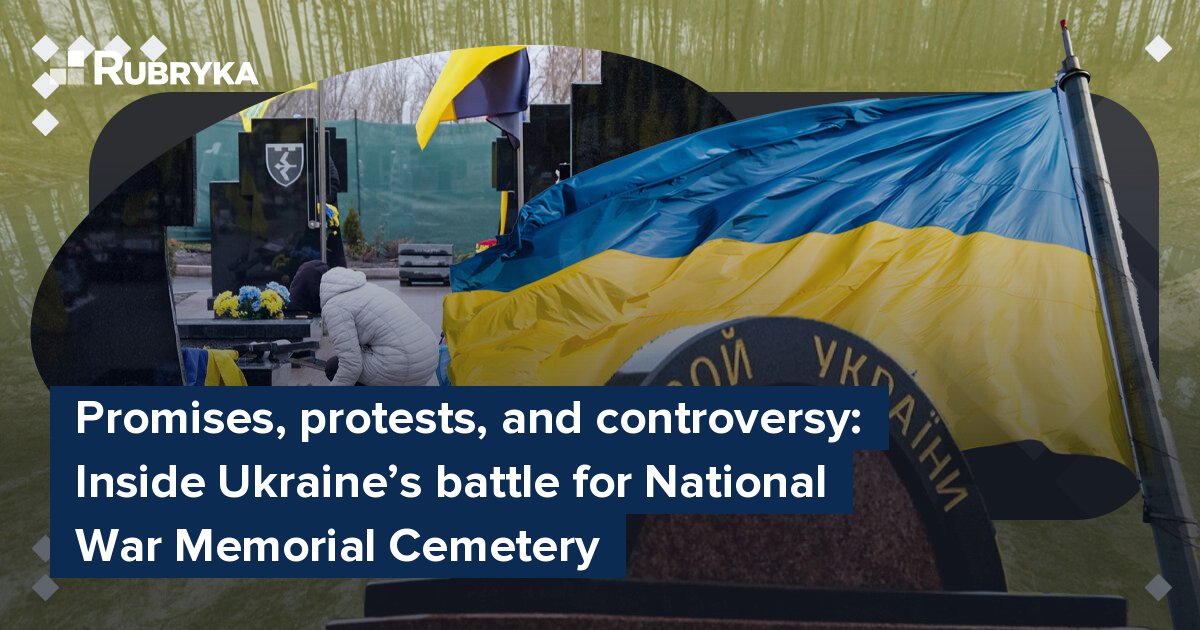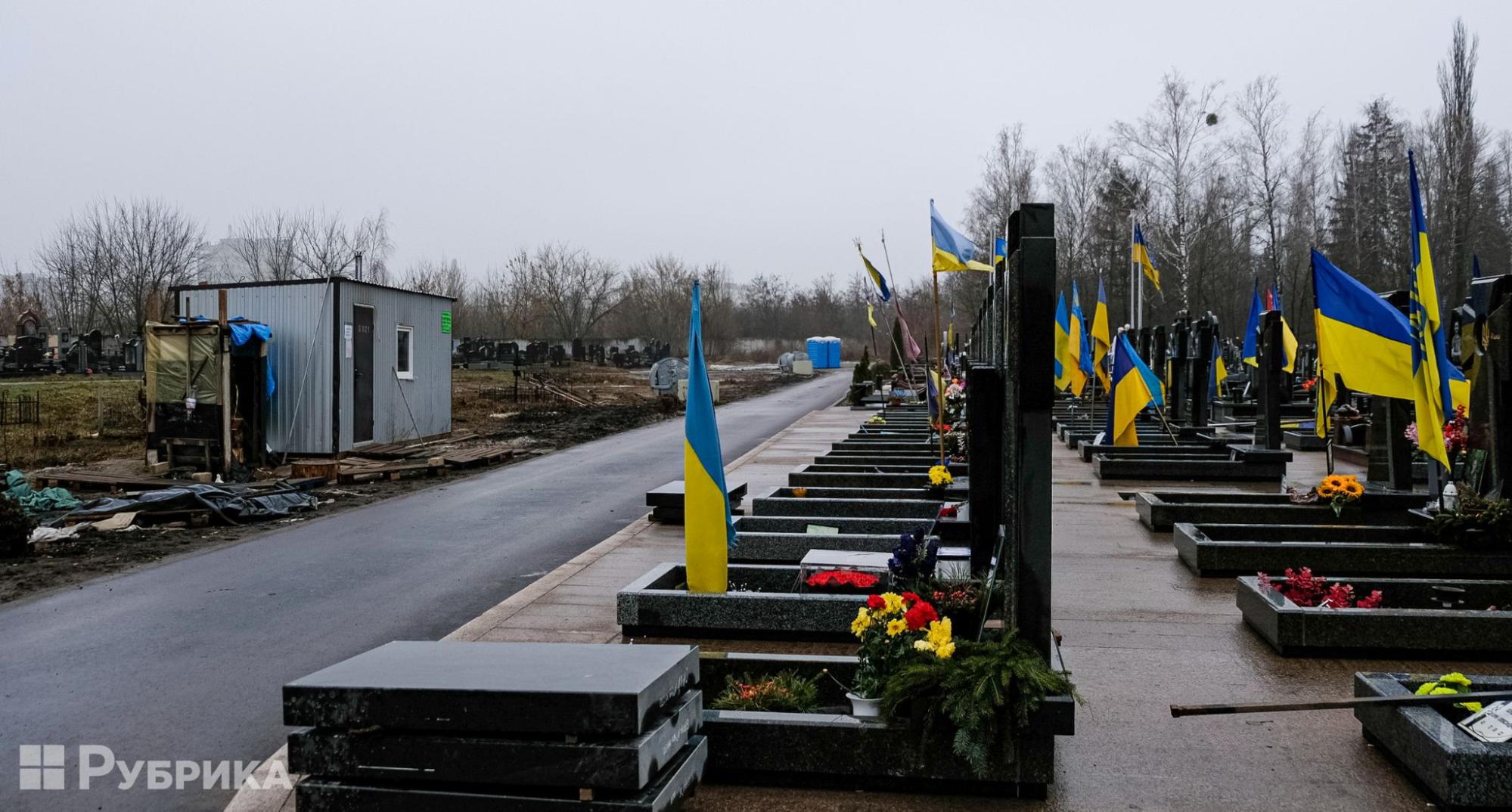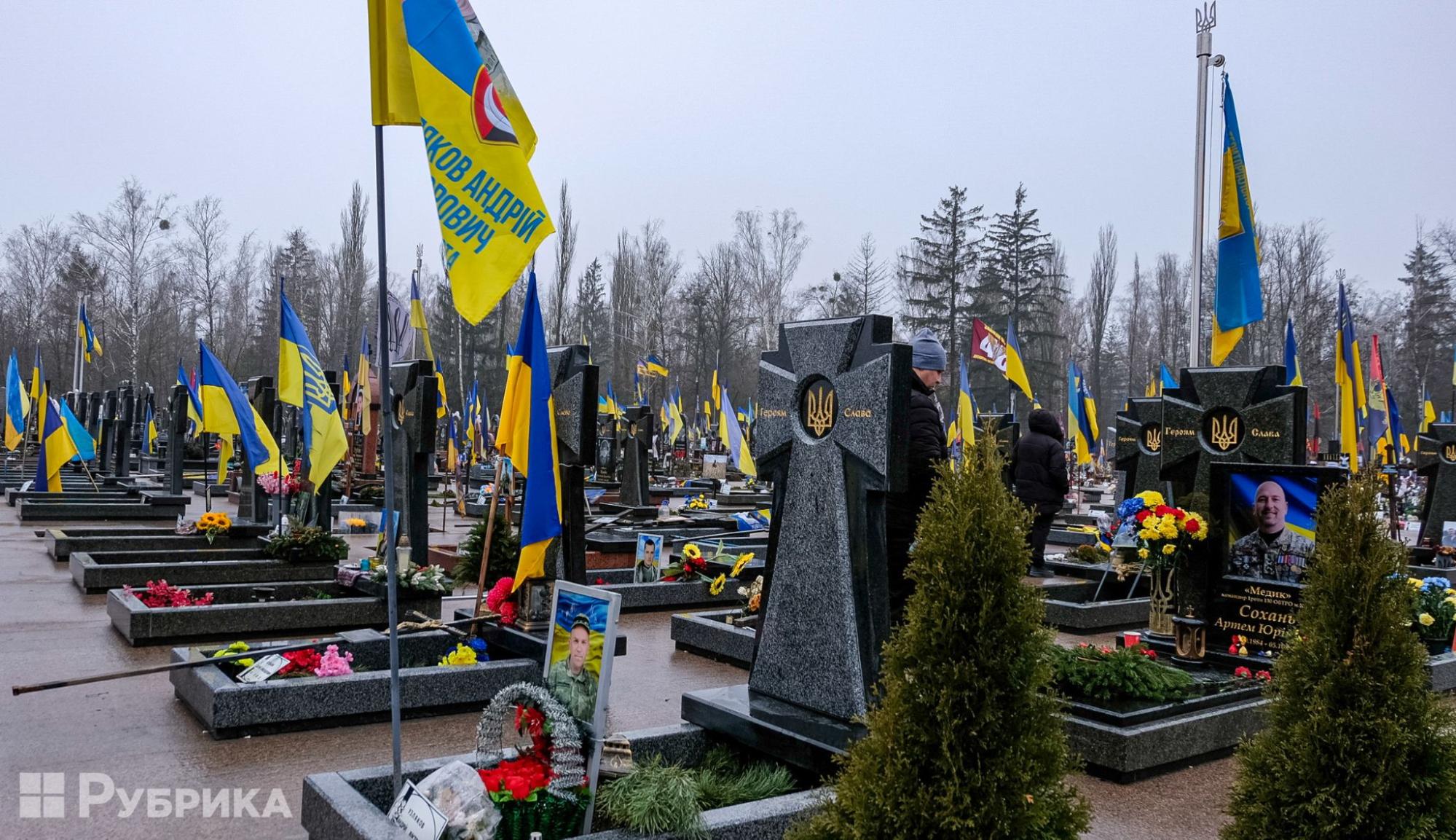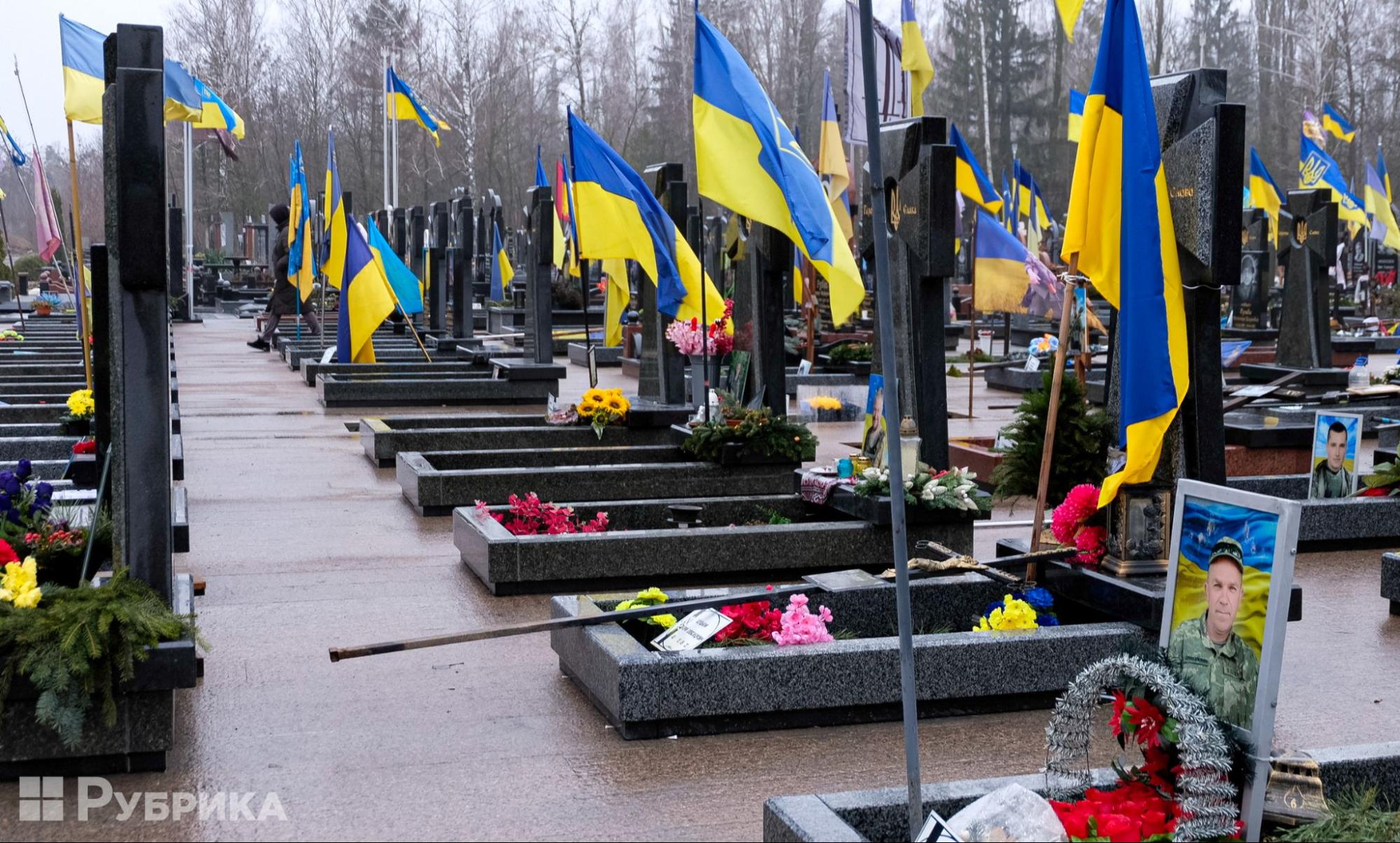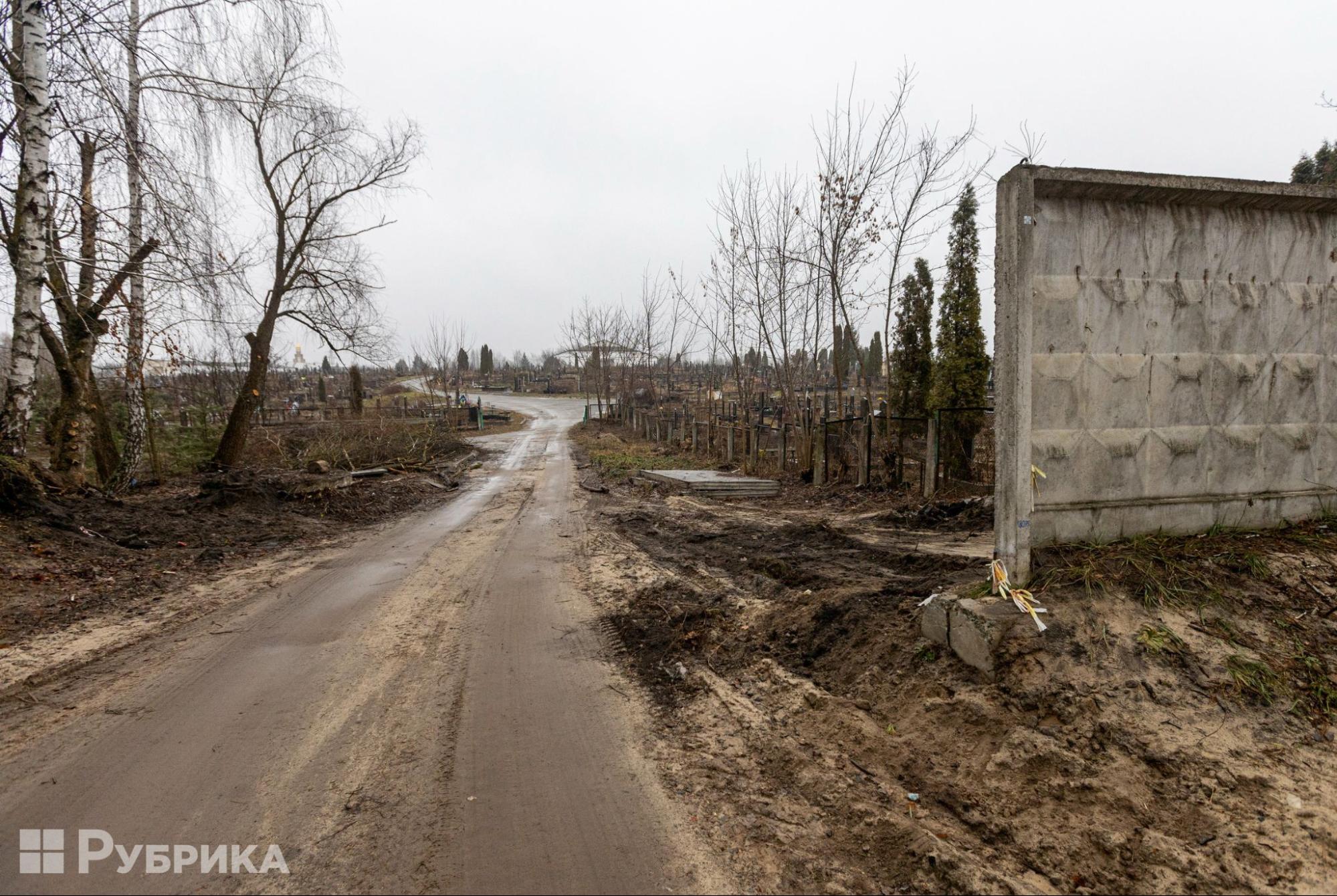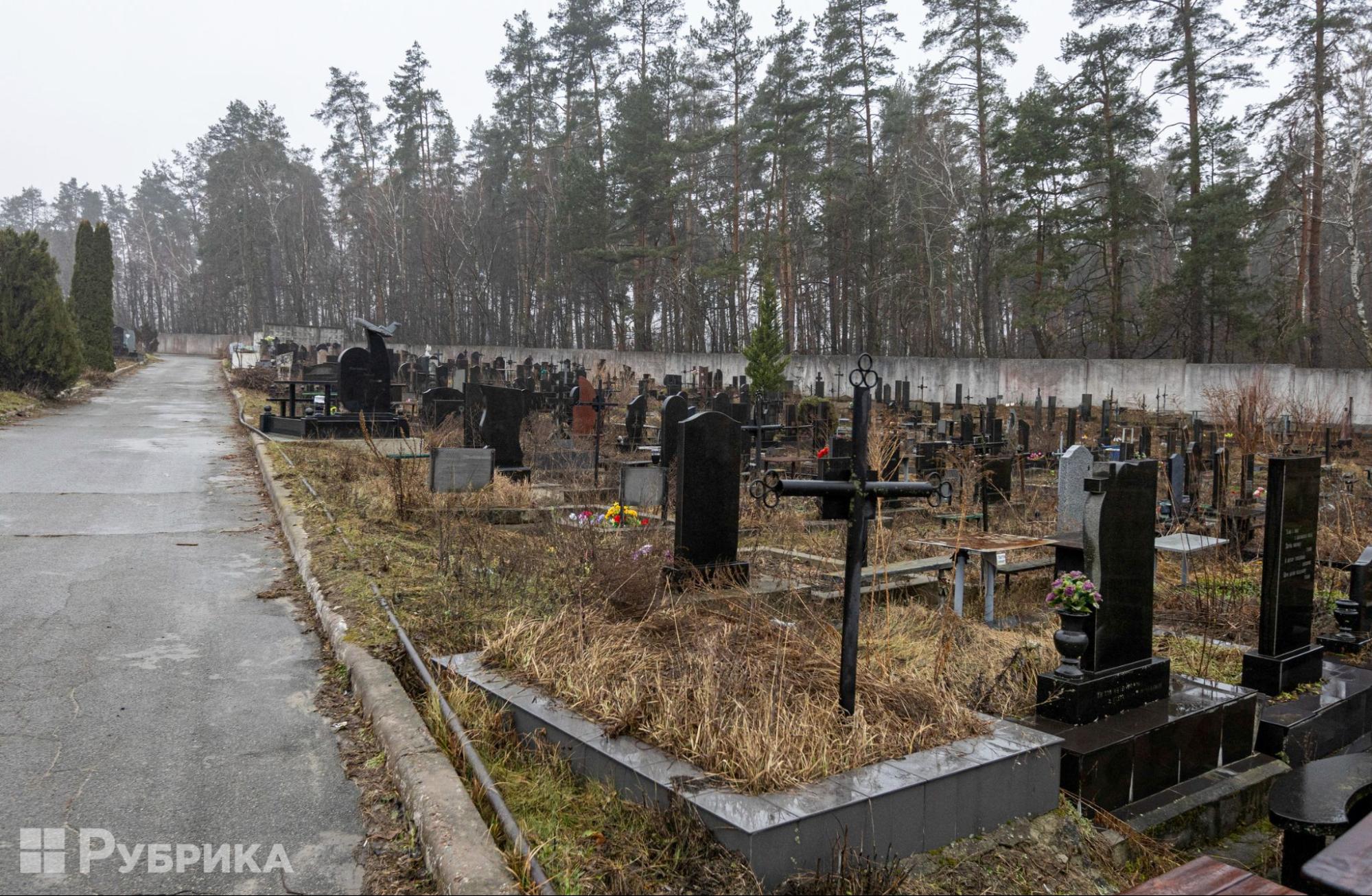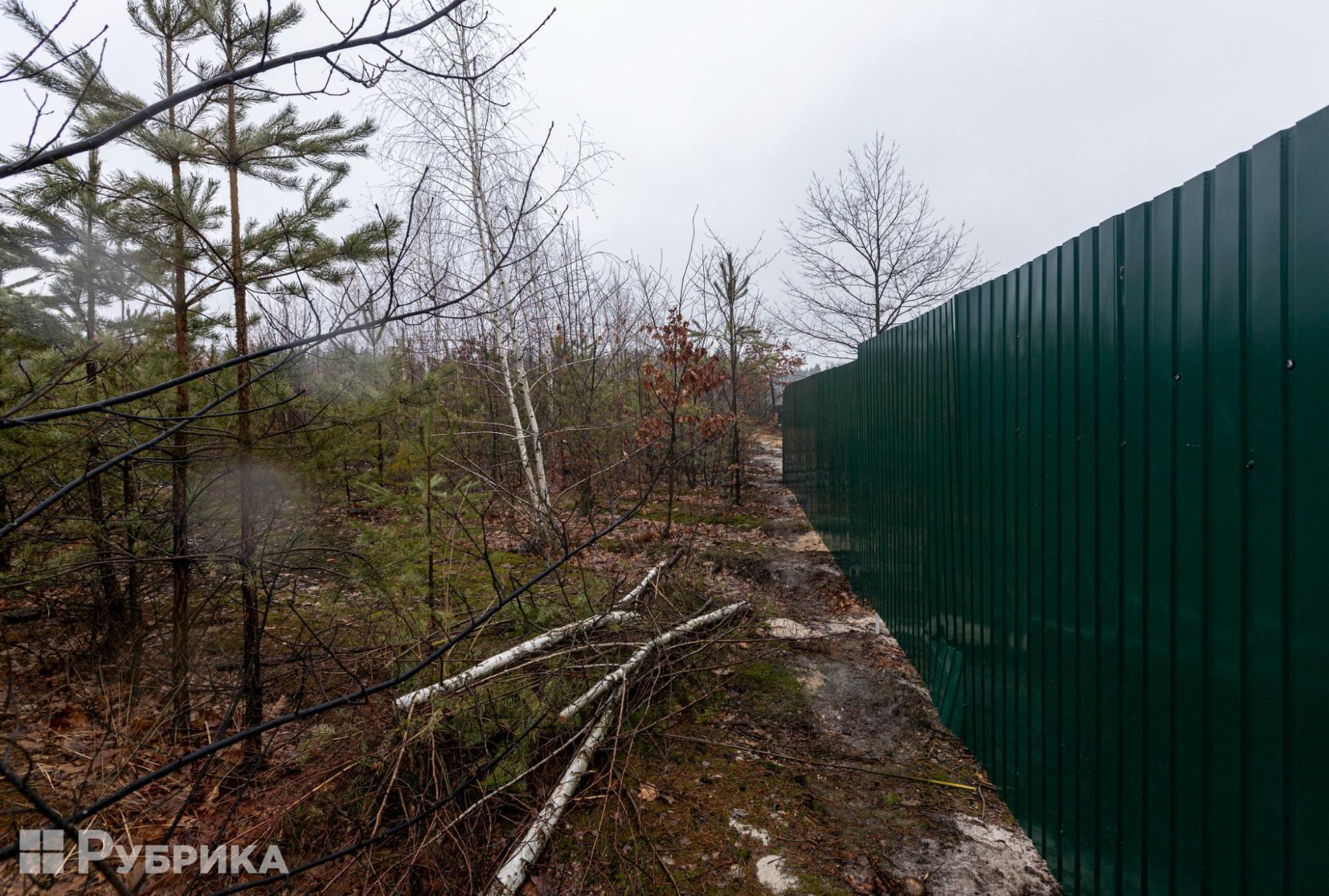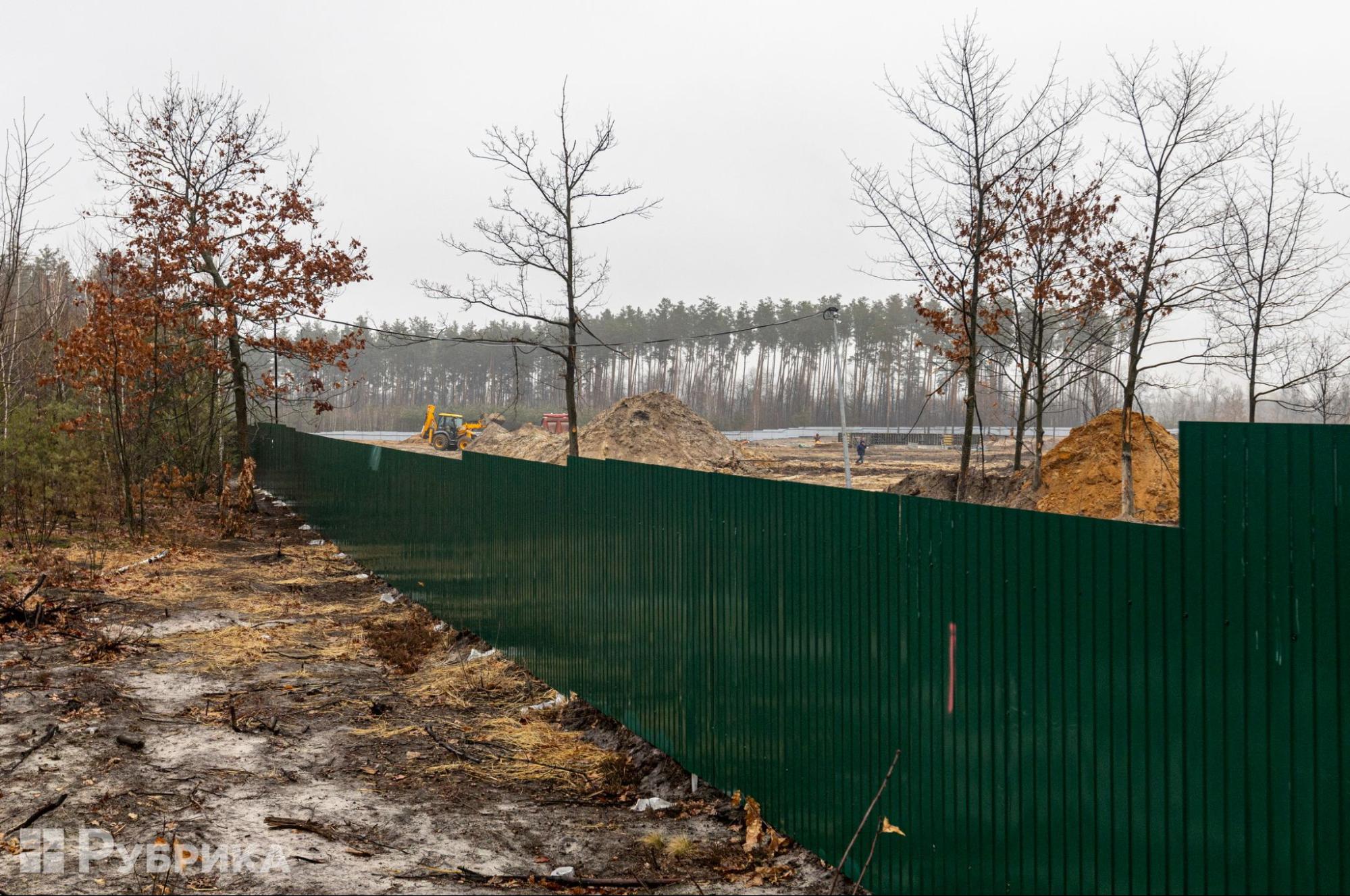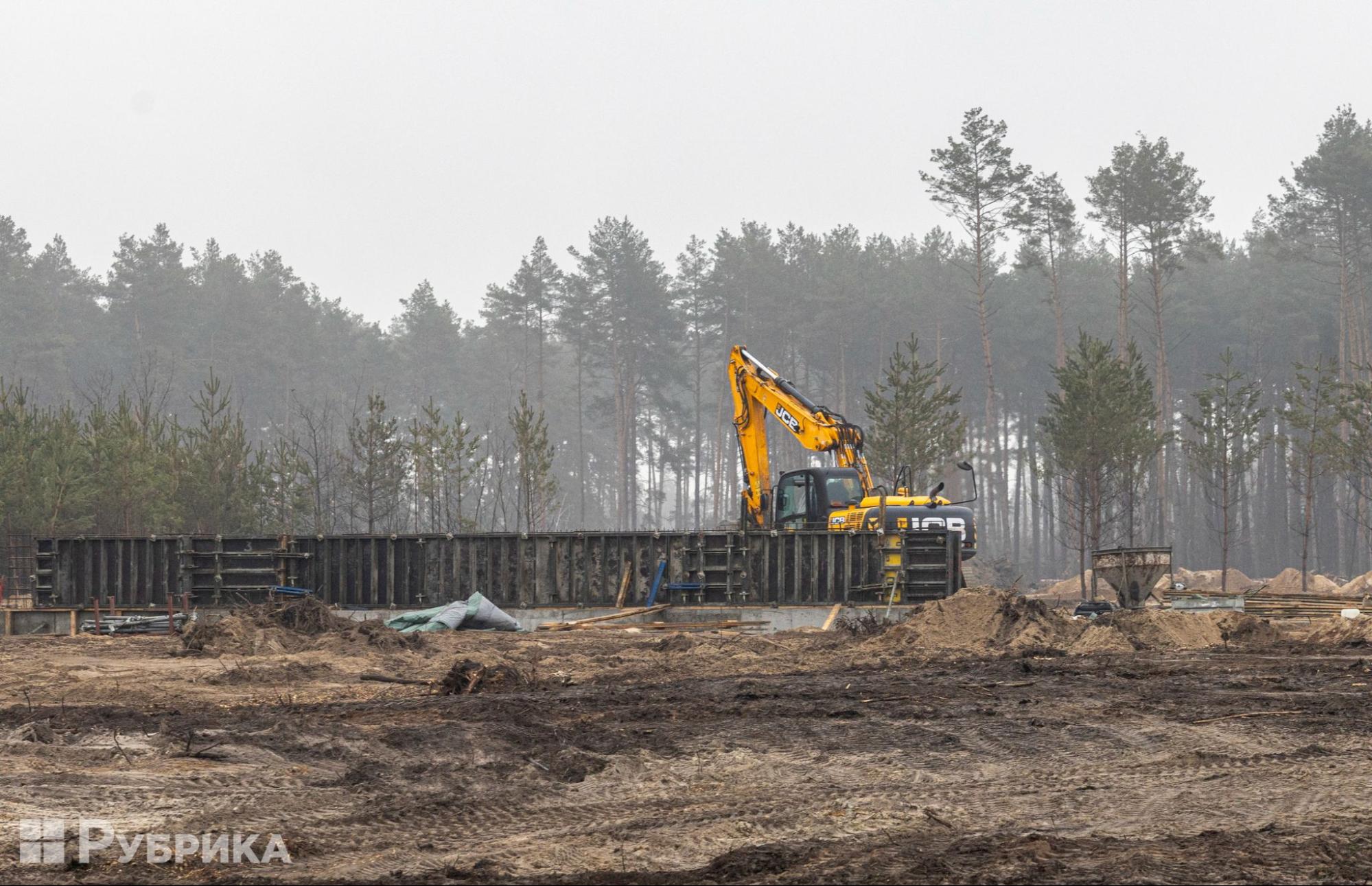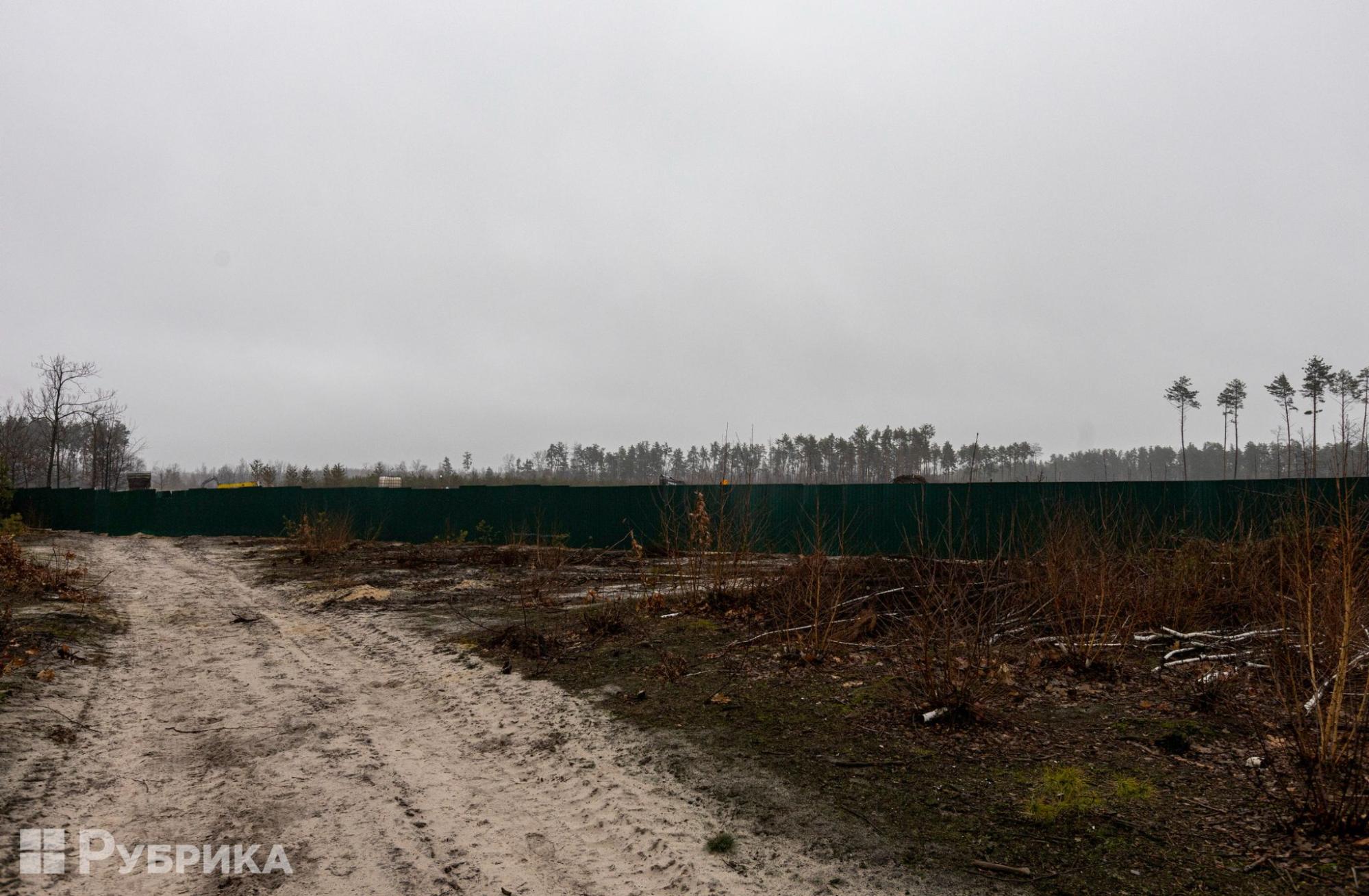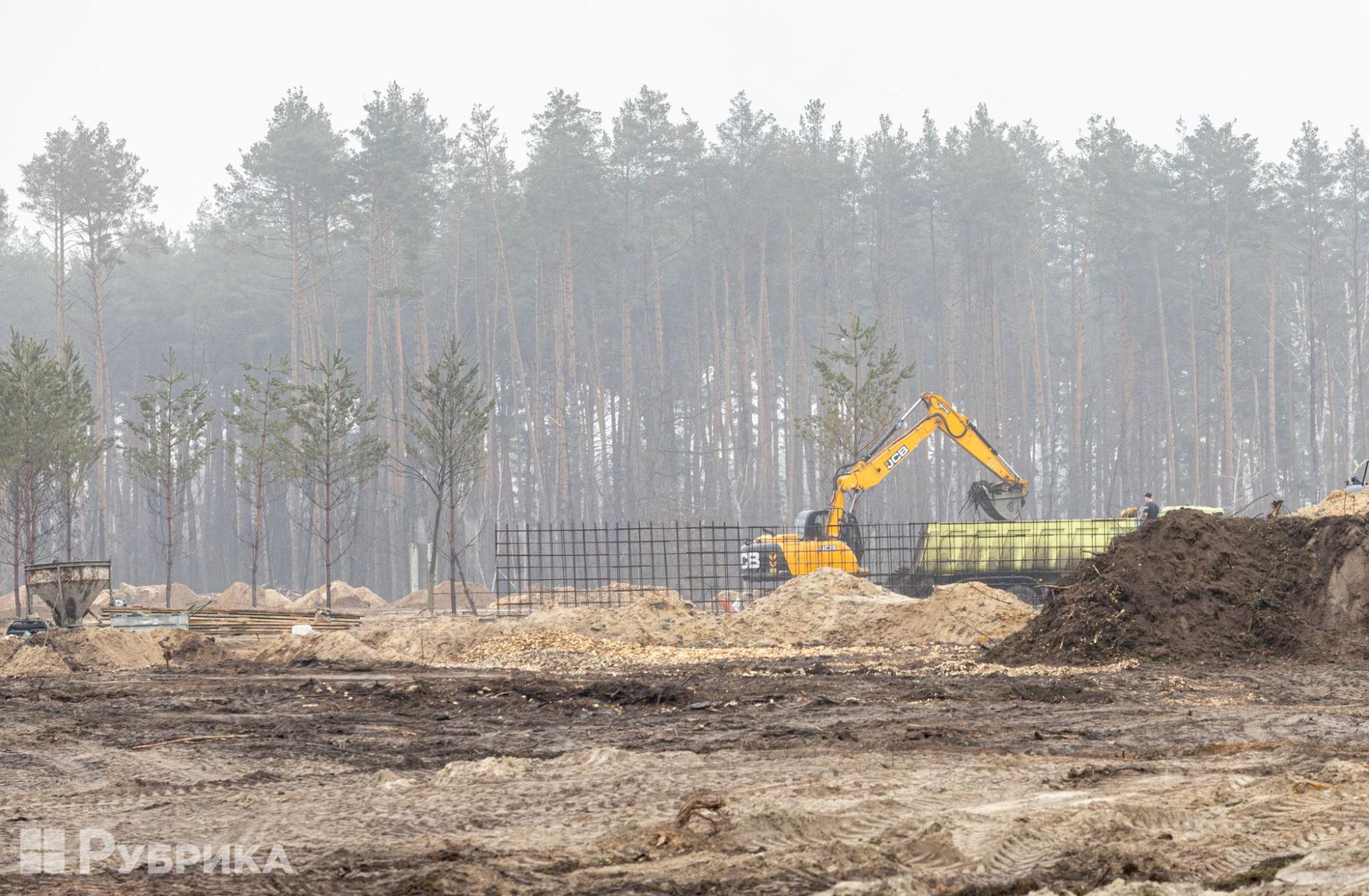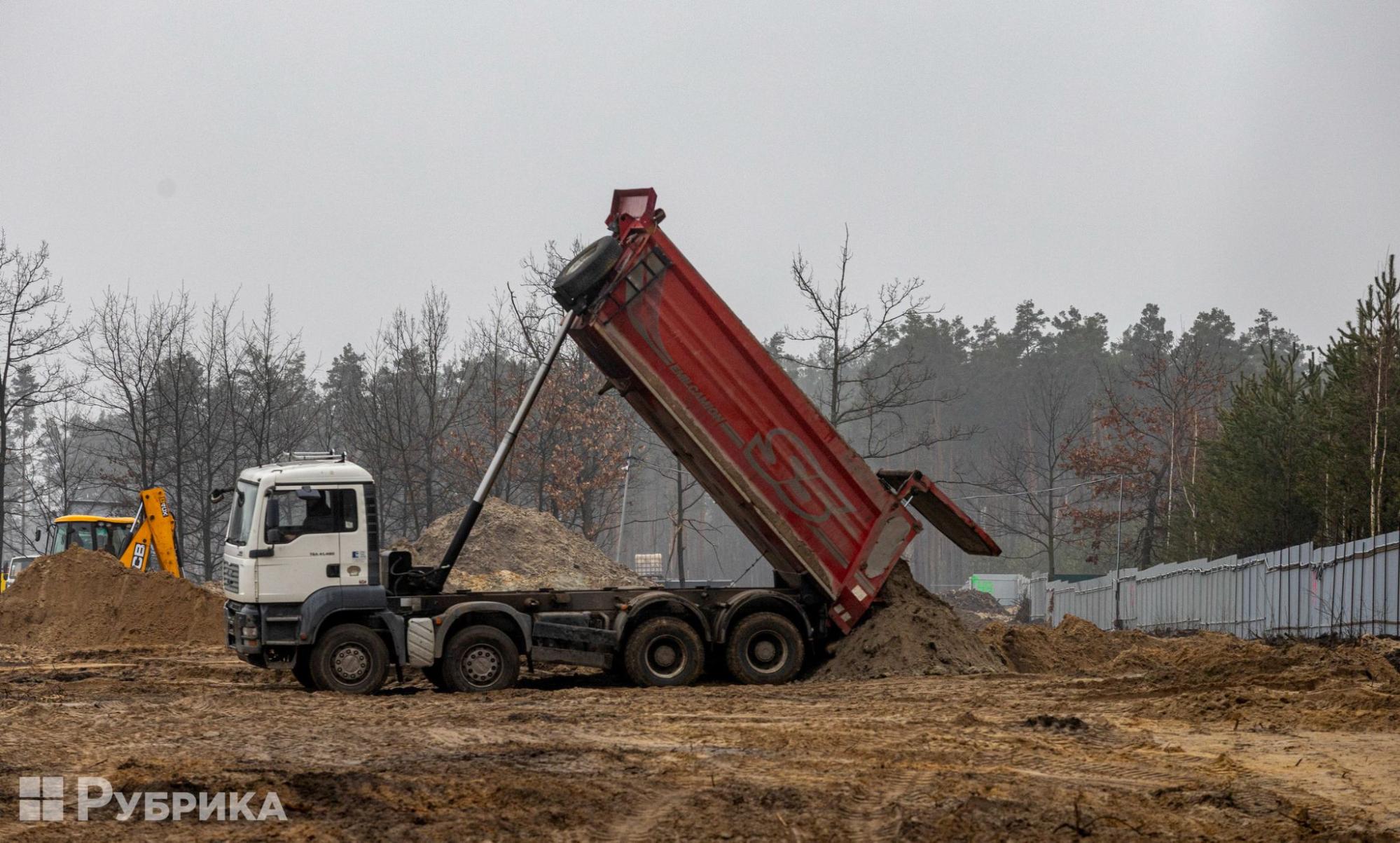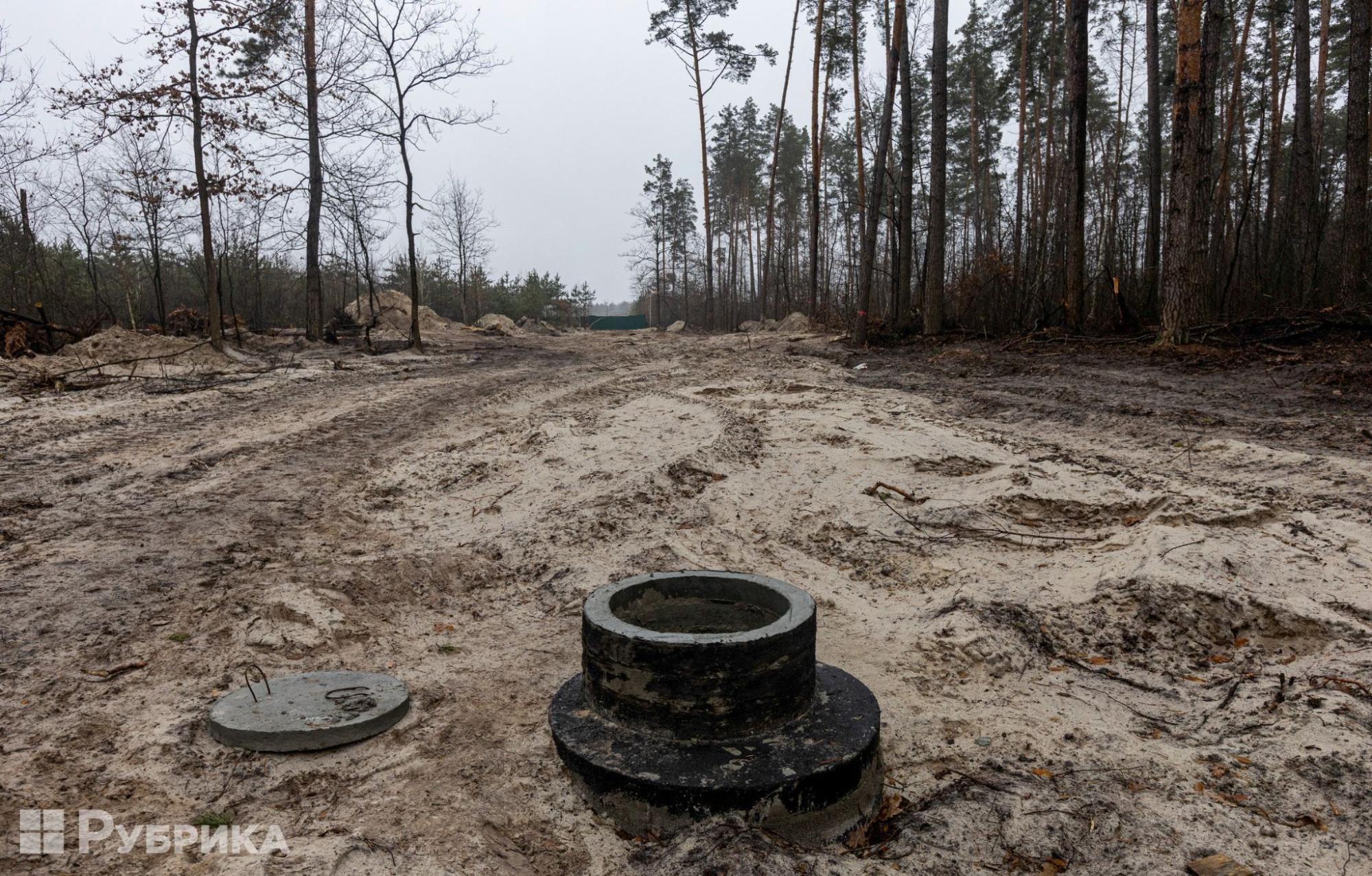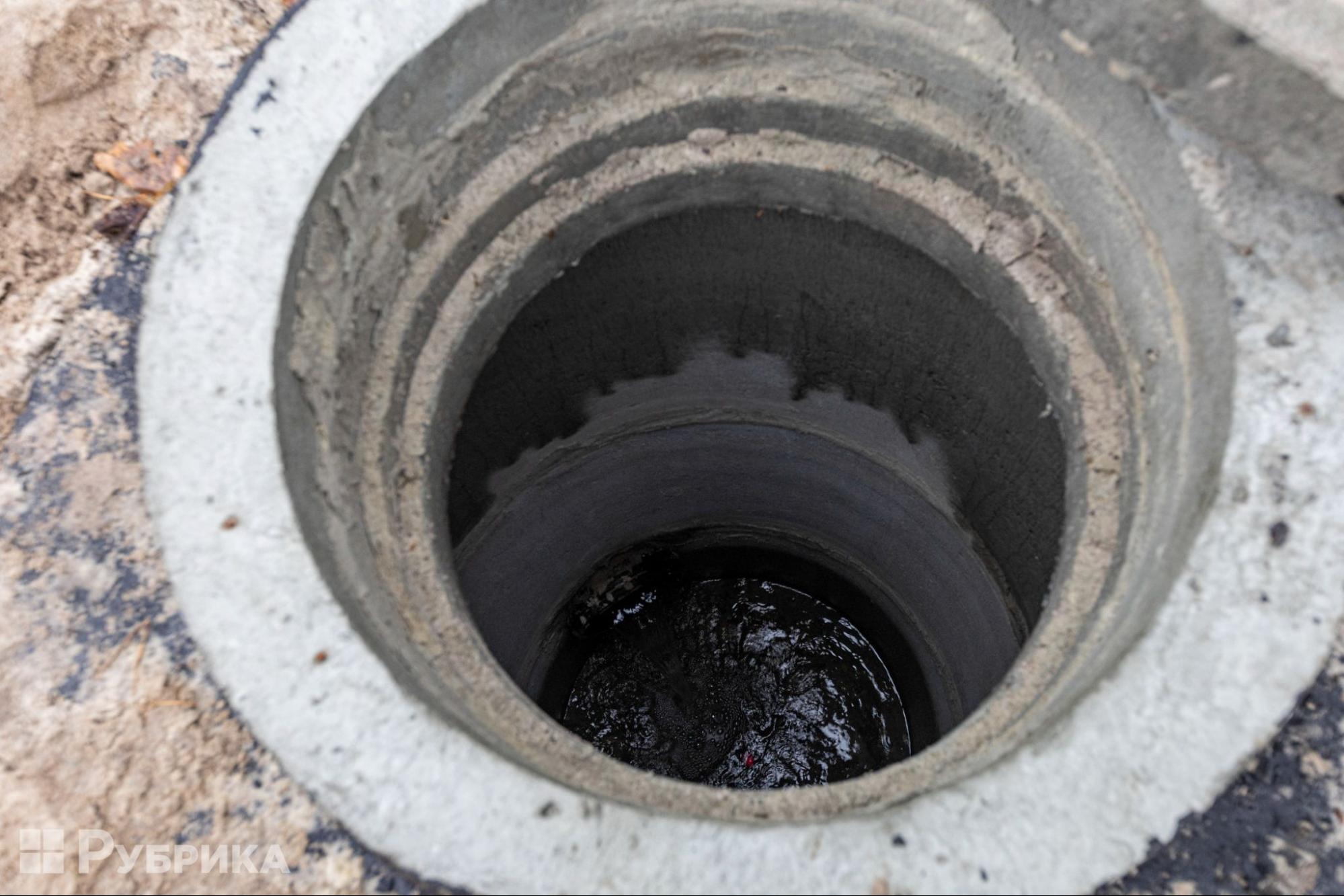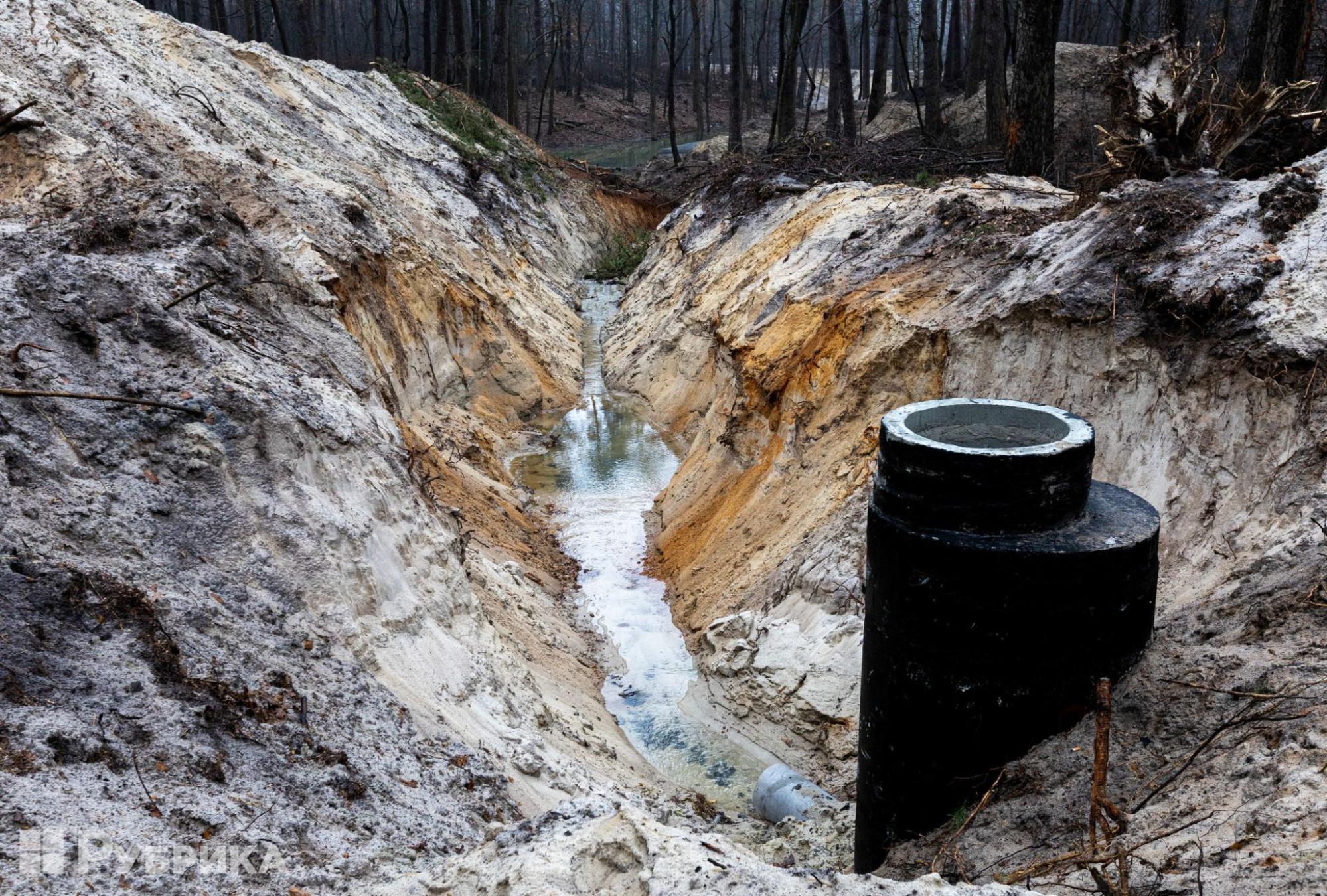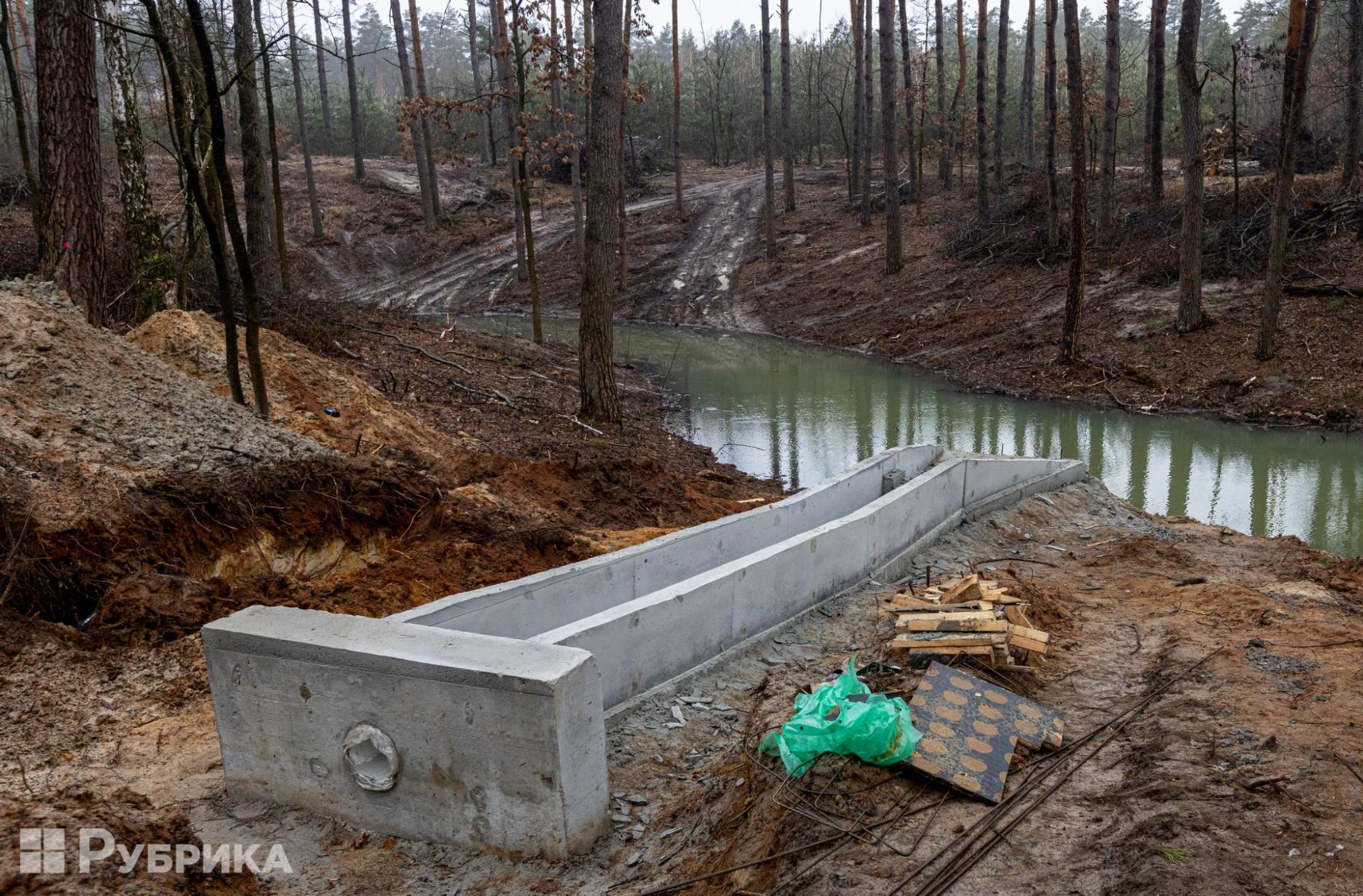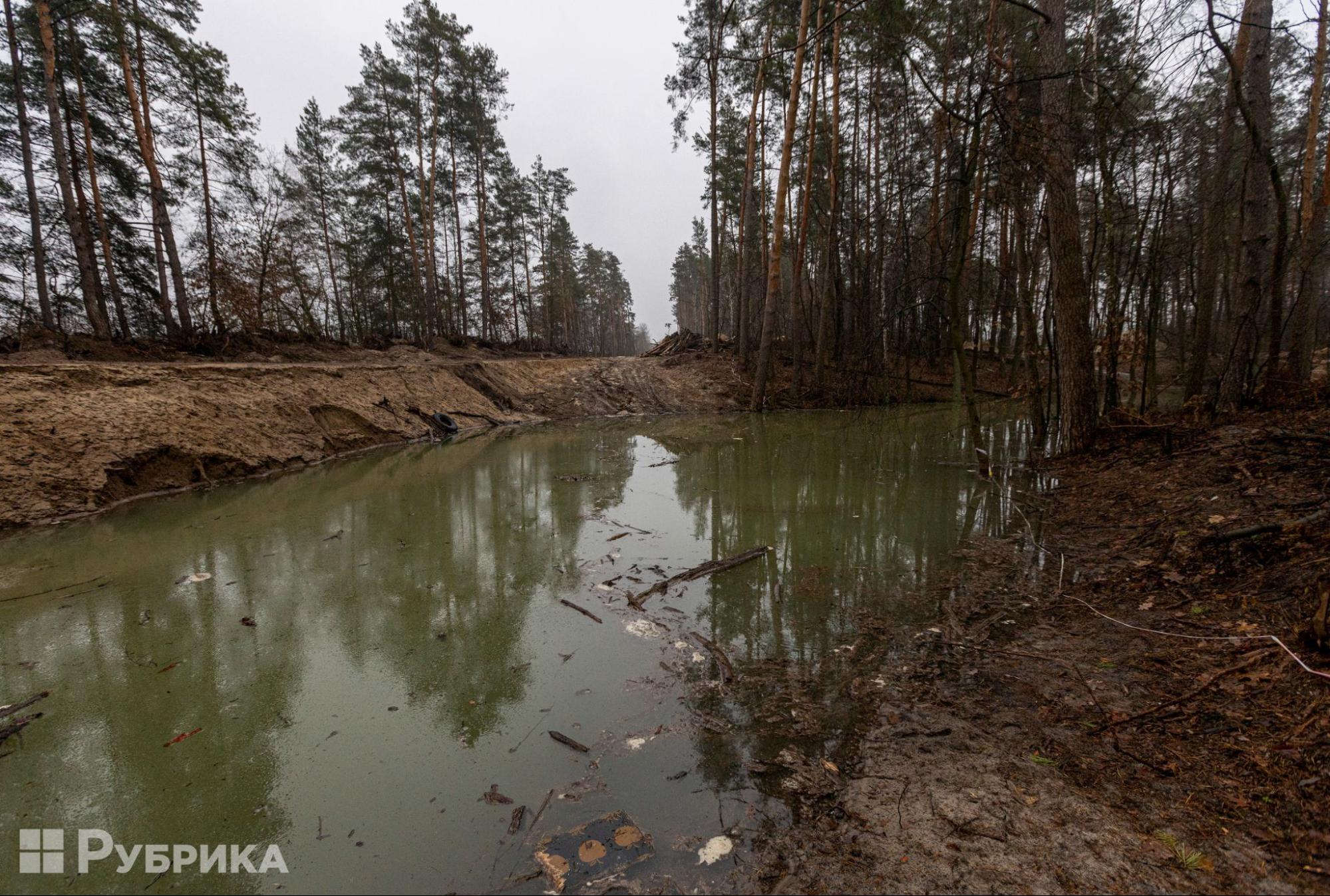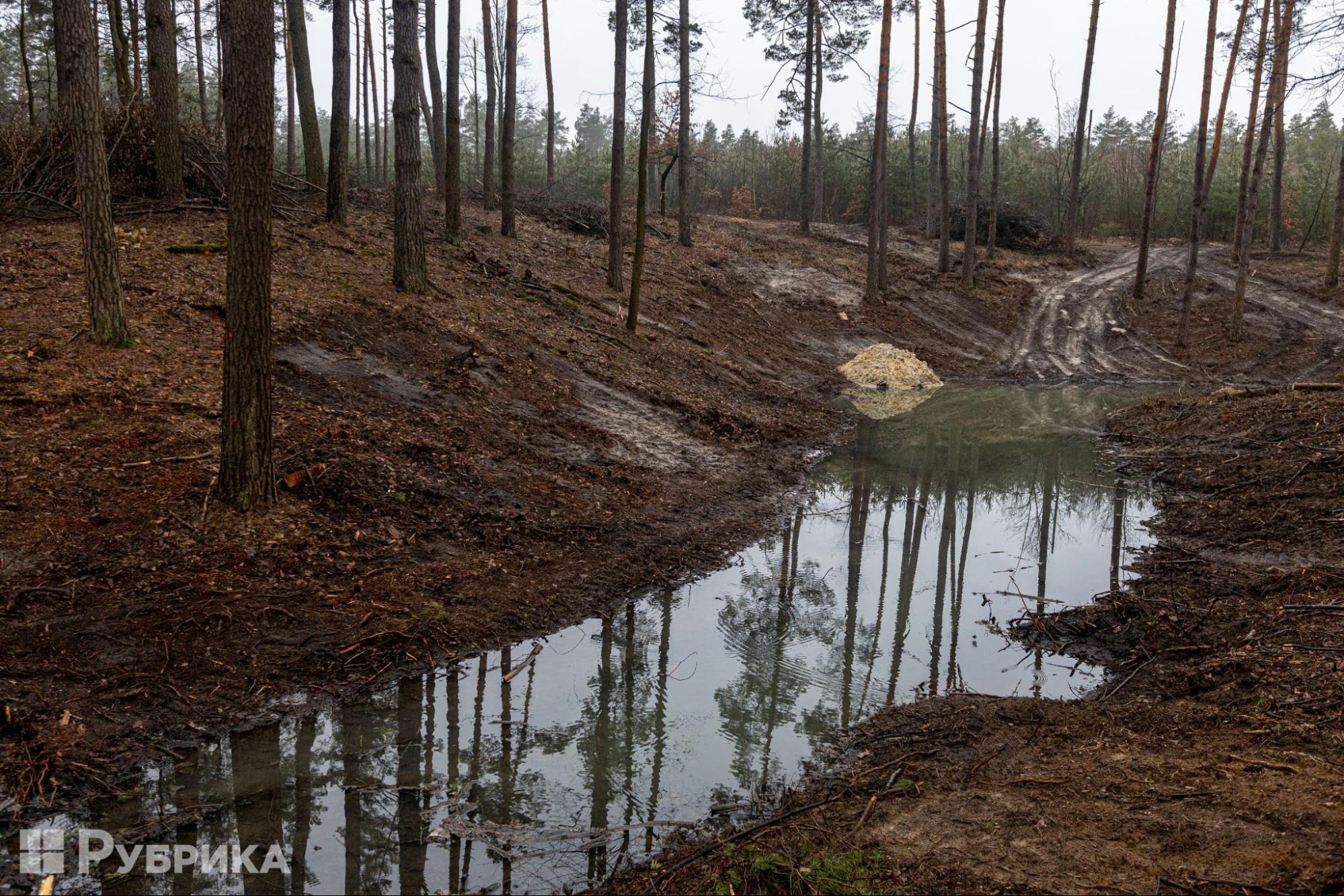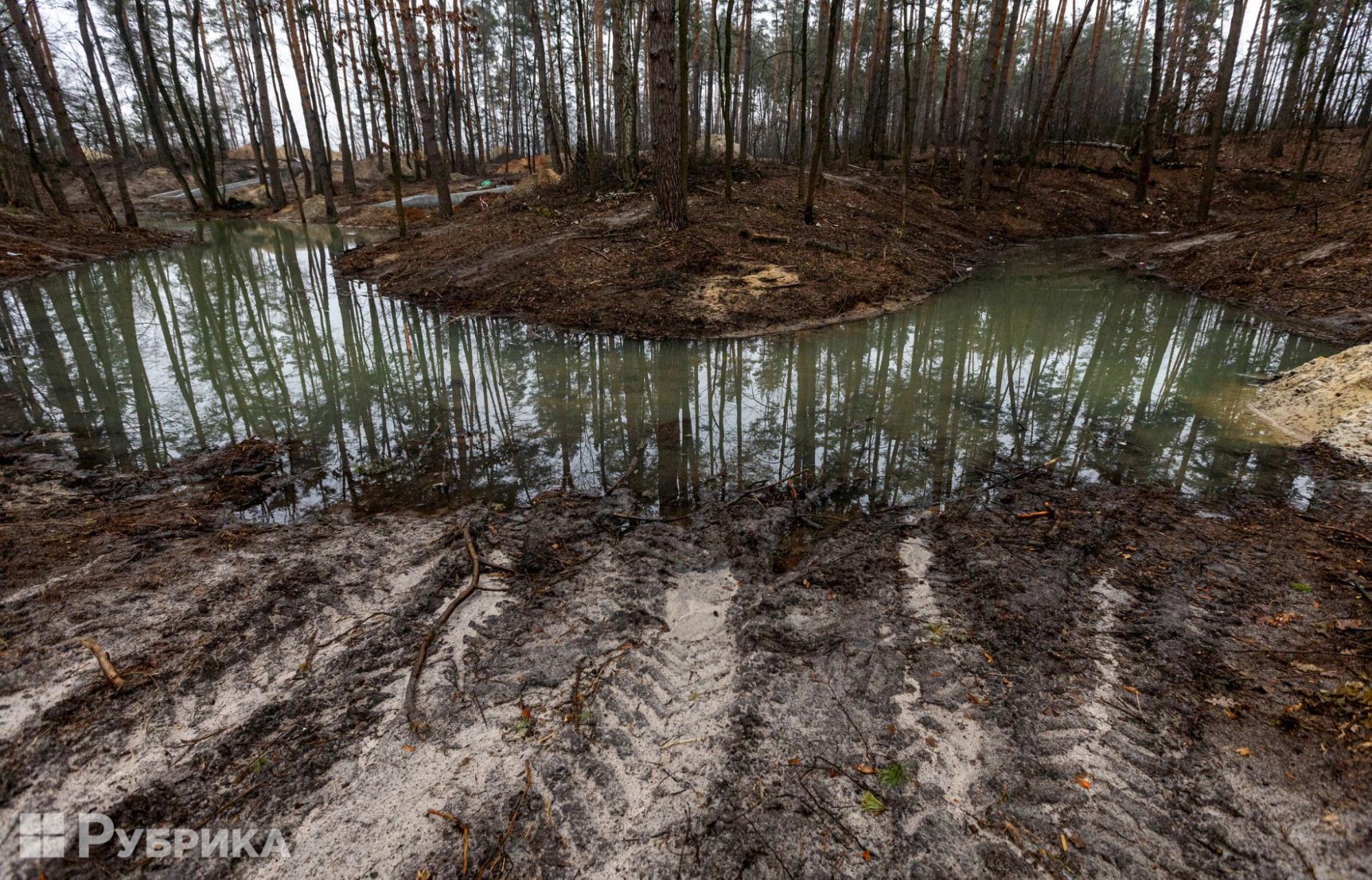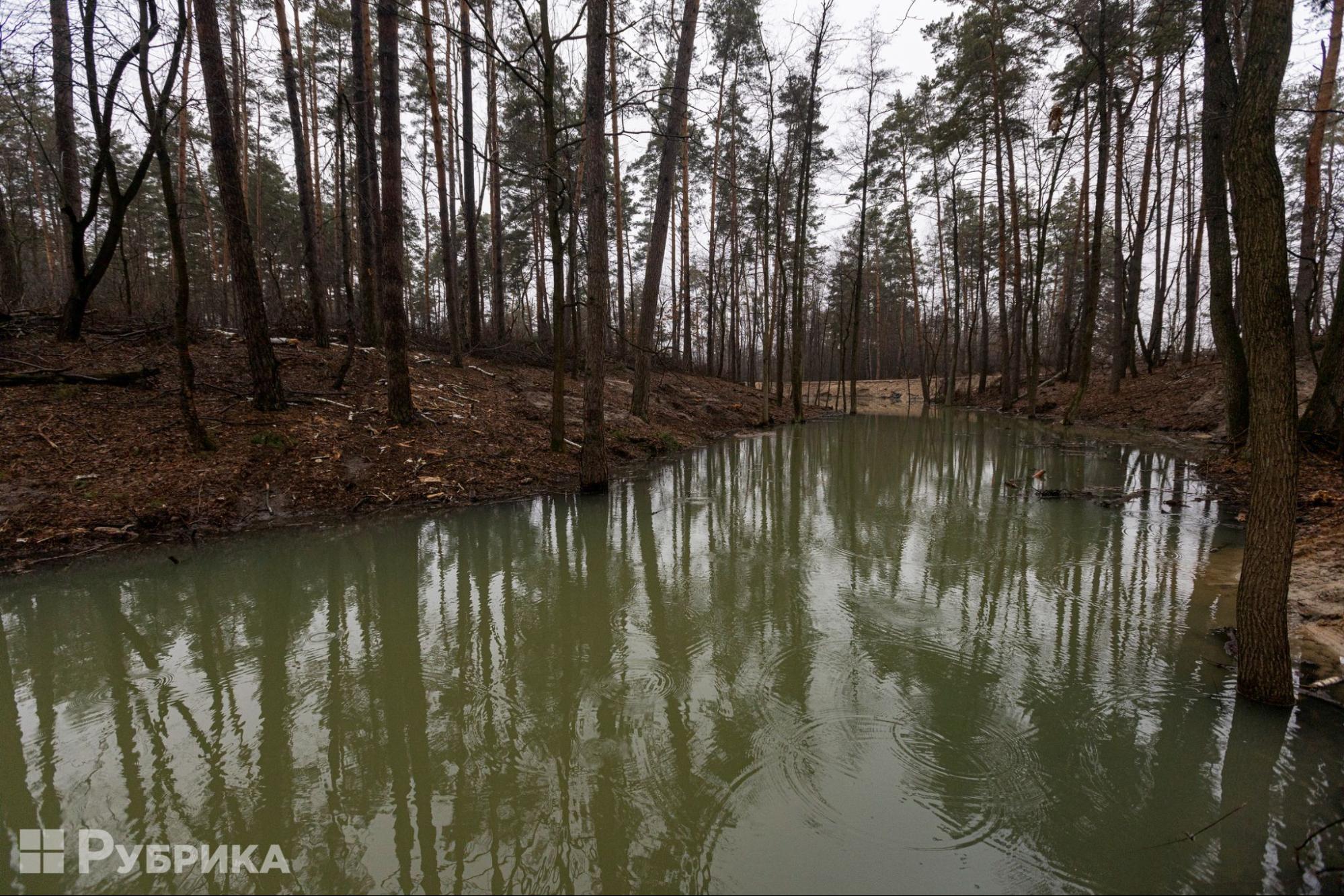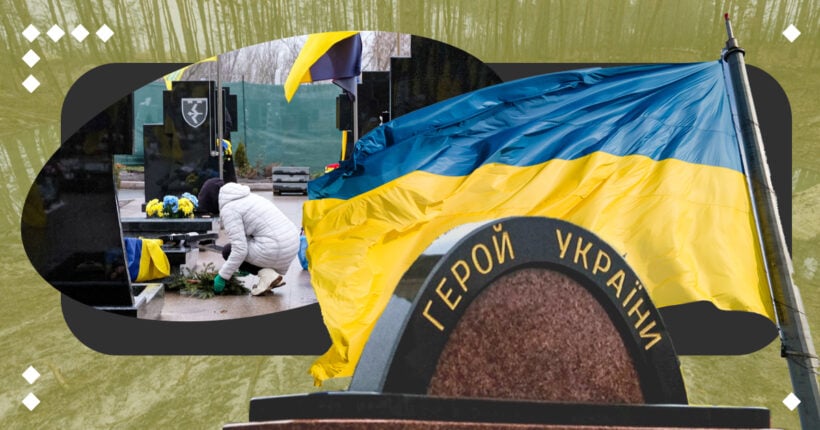
"Grief does not wait," or why Ukraine needs the NWMC as soon as possible
The first thing Inna Sokhan saw upon arriving at Berkovets Cemetery, where her husband Artem was buried, was a swamp. The section designated for fallen servicemen was covered in mud, with public toilets standing in close proximity. Visiting his grave became a challenge—she had to carry shoe covers every time, as walking through the cemetery without them was nearly impossible.
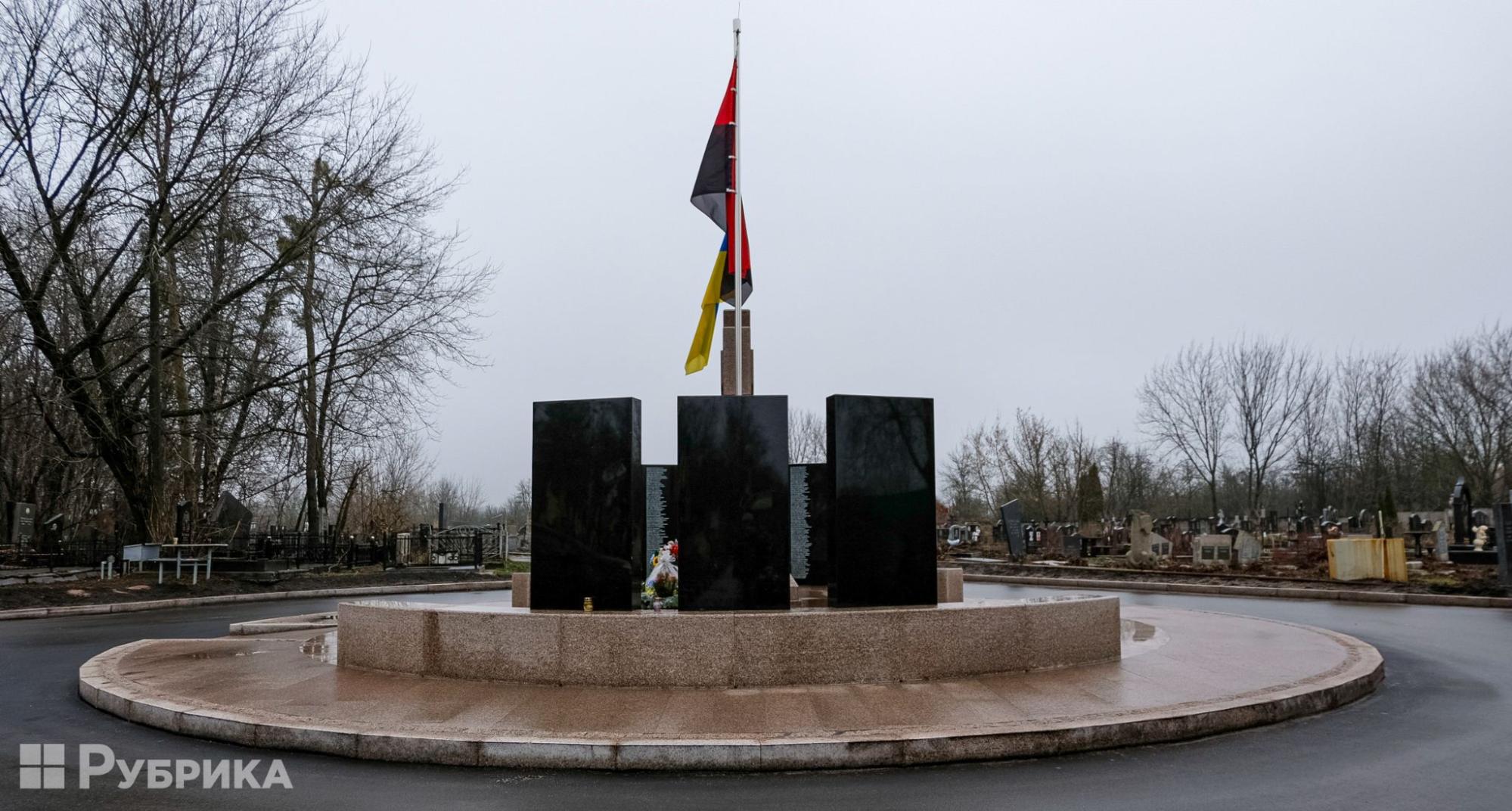
There was a public toilet on the site of the monument, which was later converted into a memorial.
"For me, it was a disgraceful situation—my husband was buried in a swamp," Sokhan recalls. "They laid him to rest and said, 'Glory to the heroes.' But there was no glory in that place. The final farewell, the burial ritual—these should be carried out with dignity and respect. As civilians, it is our duty to give this to our soldiers."
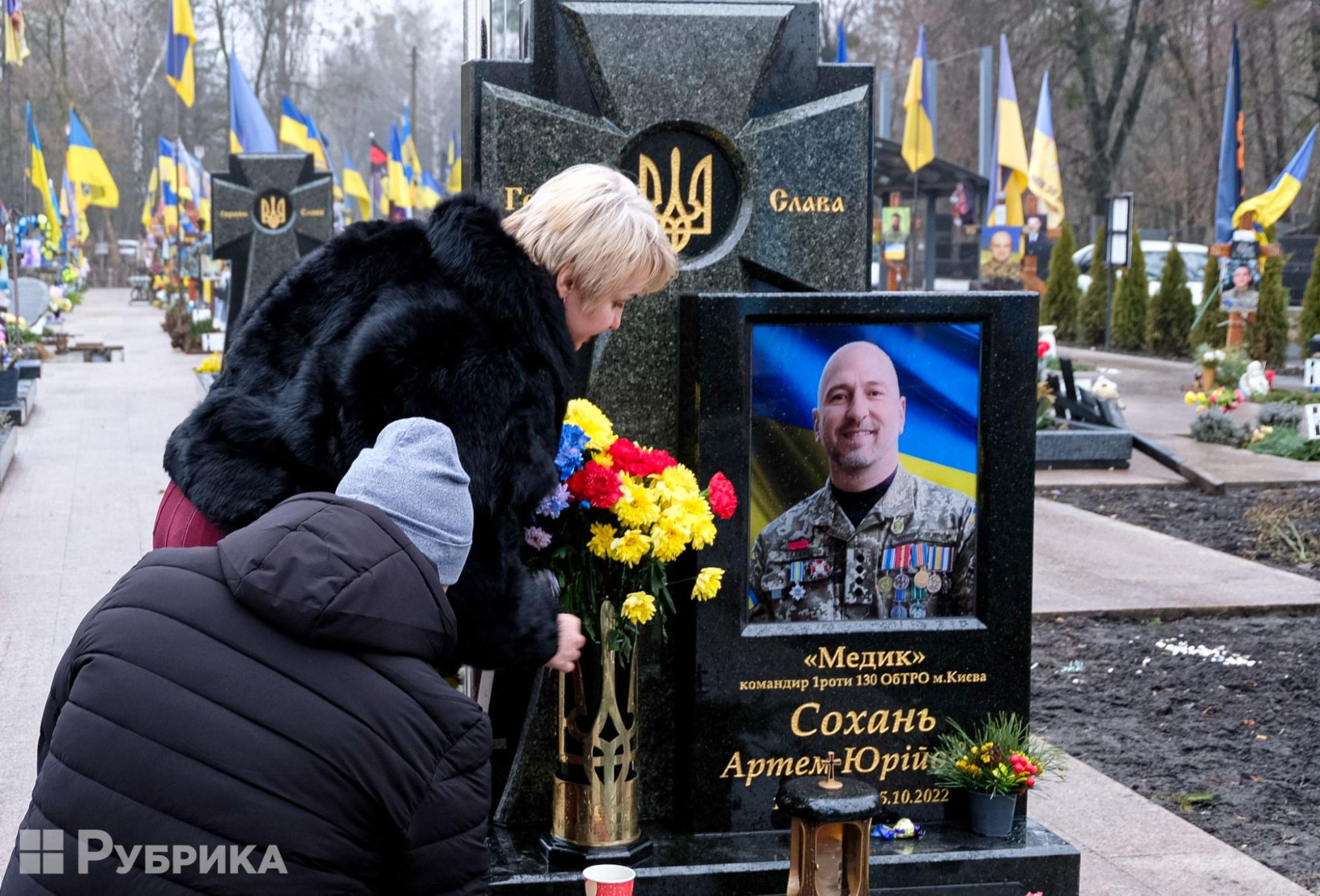
Inna Sokhan comes to the burial site every week.
Then, the families of fallen servicemen came together to fight for their right to a dignified burial. They demanded that the cemetery follow uniform standards and serve as a proper place of remembrance. However, it soon became clear that Kyiv was unprepared for this. The city lacked a clear plan for the burial of soldiers, and the recommendations issued by the Institute of National Remembrance were merely advisory, not legally binding.
In the end, the Kyiv City State Administration responded to the community's demands and, over two years, fulfilled its promise to unify and improve the cemetery. However, many families could not wait for the local authorities to complete the renovations and continued burying their loved ones in whatever way they could. As a result, Berkovetske Cemetery now presents a striking contrast—grand monuments erected for some of the deceased partially encroach upon the burial sites of others.
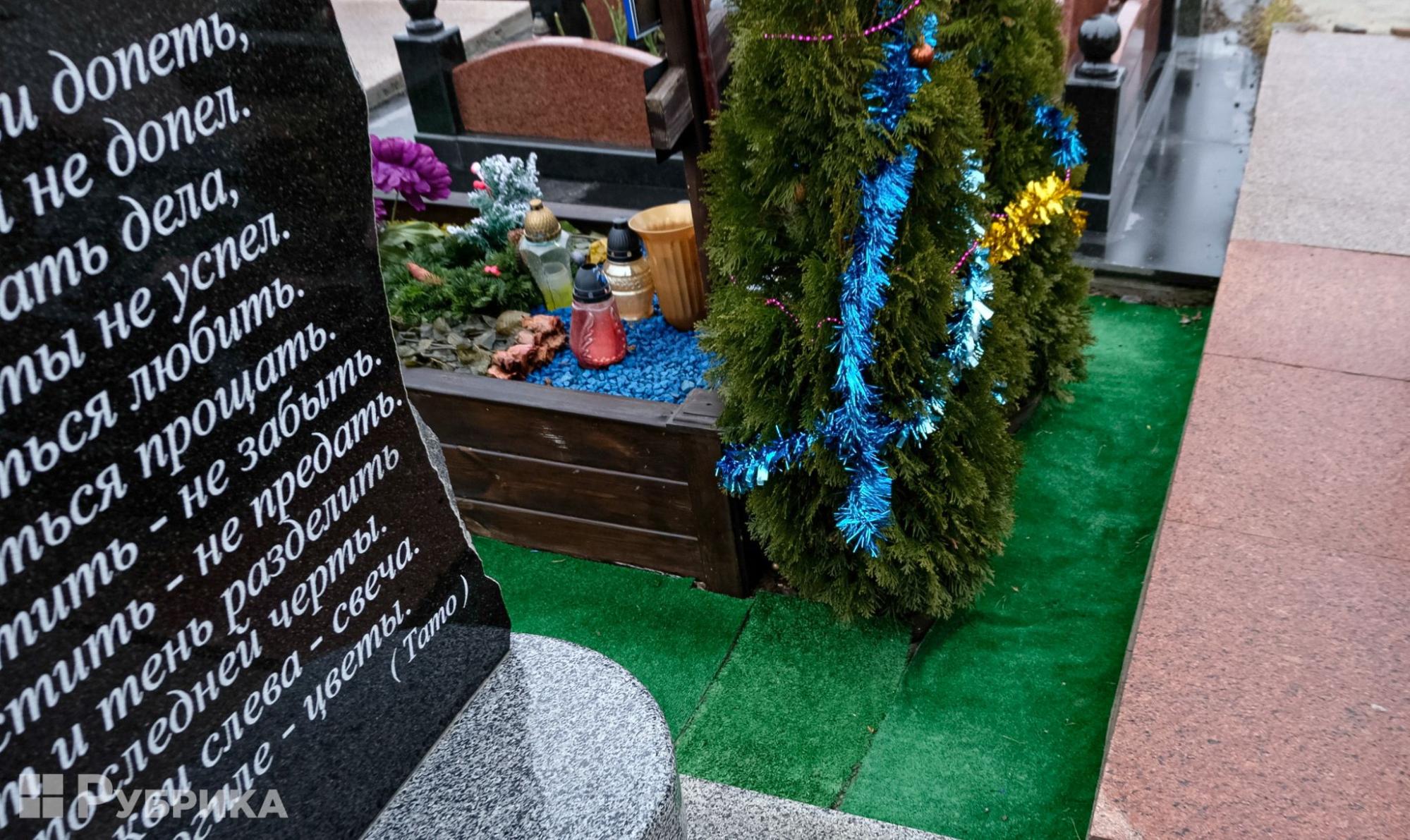
Due to non-compliance with the norms, some burials received a smaller plot than stipulated by the authorities.
"There were disagreements when the decision was made to unify the monuments. In Ukraine, it's common for families to personally maintain graves, sometimes even planting flowers or vegetables nearby. Some believe their fallen loved one deserves the grandest monument, while others, like orphans, have no one to erect one for them.
But it's not for us to judge who was more heroic. They all gave their lives for our future. Ranks and titles exist, but that shouldn't mean some are honored more than others. To each family, their fallen loved one is a hero," says Sokhan.
Historian Anton Liahusha explains that memory often becomes a source of conflict:
"A hierarchy emerges in how we honor the dead—high-profile figures receive grand funerals and visits from politicians, while others are buried quietly in remote villages. But this isn't a hierarchy of heroism—it's an injustice in how memorialization takes shape, in who gets remembered and how."
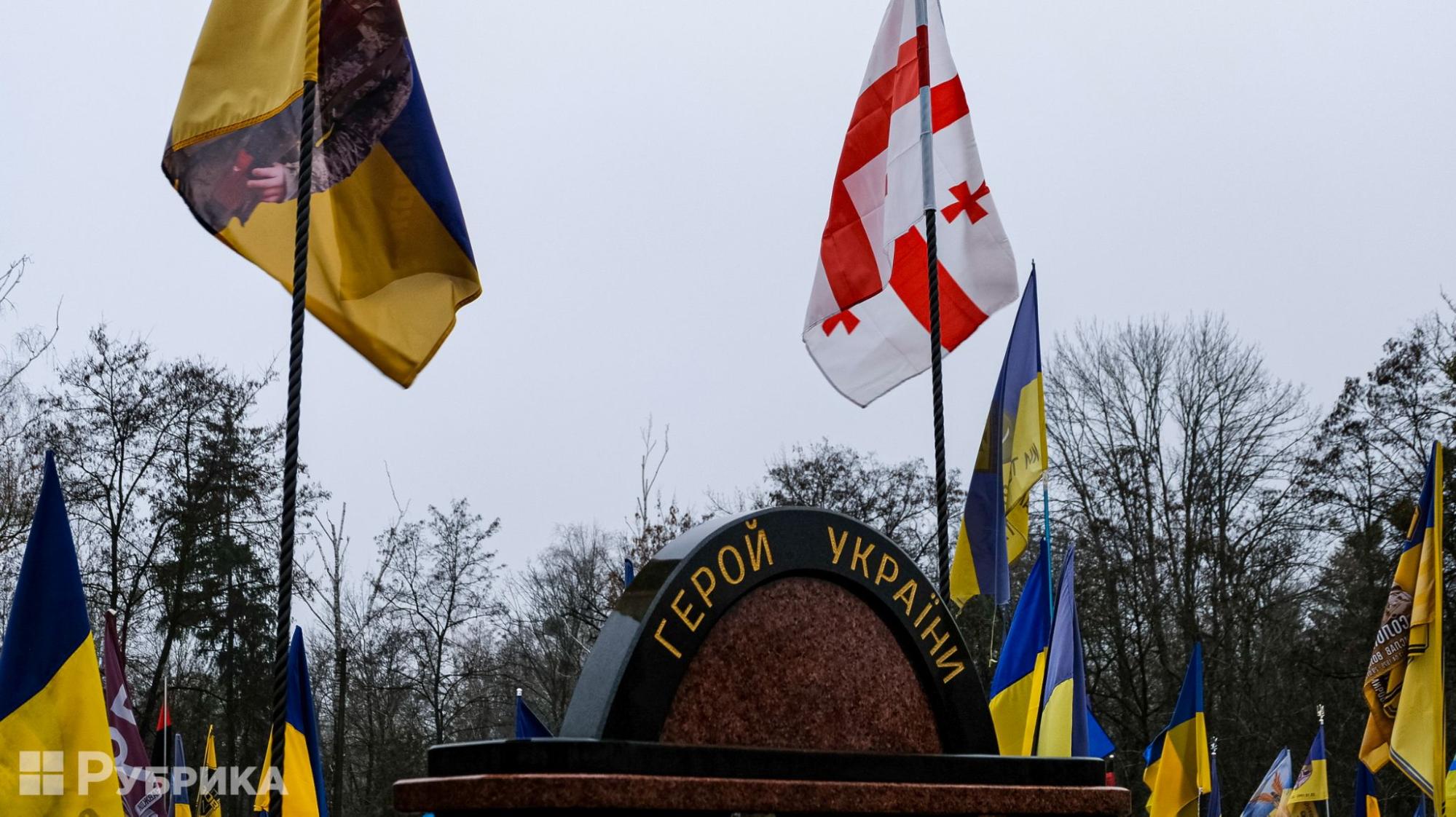
"Servicemen should be in uniform both in life and after death. We have no right to judge heroism by the size of a monument," says Sokhan.
The National War Memorial Cemetery was meant to resolve this by ensuring all tombstones follow a unified design. However, since Russia's war against Ukraine began in 2014, families of fallen soldiers have had to fight for dignified burials on their own. The cemetery's construction has now been delayed for nearly three years.
Some families are still keeping their loved ones' ashes at home, waiting for a proper resting place. The memorial will also include cenotaphs—symbolic graves—for those whose bodies were never recovered, offering families a space to mourn.
The state has also committed to maintaining all graves, which is crucial since not every fallen soldier has family left to care for their resting place. Currently, in many cemeteries, graves without relatives remain neglected.
At Berkovetske Cemetery, the community reached an agreement with authorities to ensure they fund and maintain standardized gravestones. This means that no matter what happens in the next 5–10 years—whether due to vandalism or natural disasters—the government is responsible for repairs and upkeep.

Berkovets cemetery today.
The National War Memorial also provides a resting place for those who have lost their homes or whose homes are in temporarily occupied territories. Additionally, it allows military brigades to bury fallen soldiers together, honoring the bonds they shared in life.
However, Sokhan emphasizes that unification should extend beyond the National Memorial. Many soldiers are buried not only in Kyiv but across communities throughout Ukraine. "It would be good to have a single state program, a unified burial concept. No matter where a hero is laid to rest, their grave should be instantly recognizable," she says.
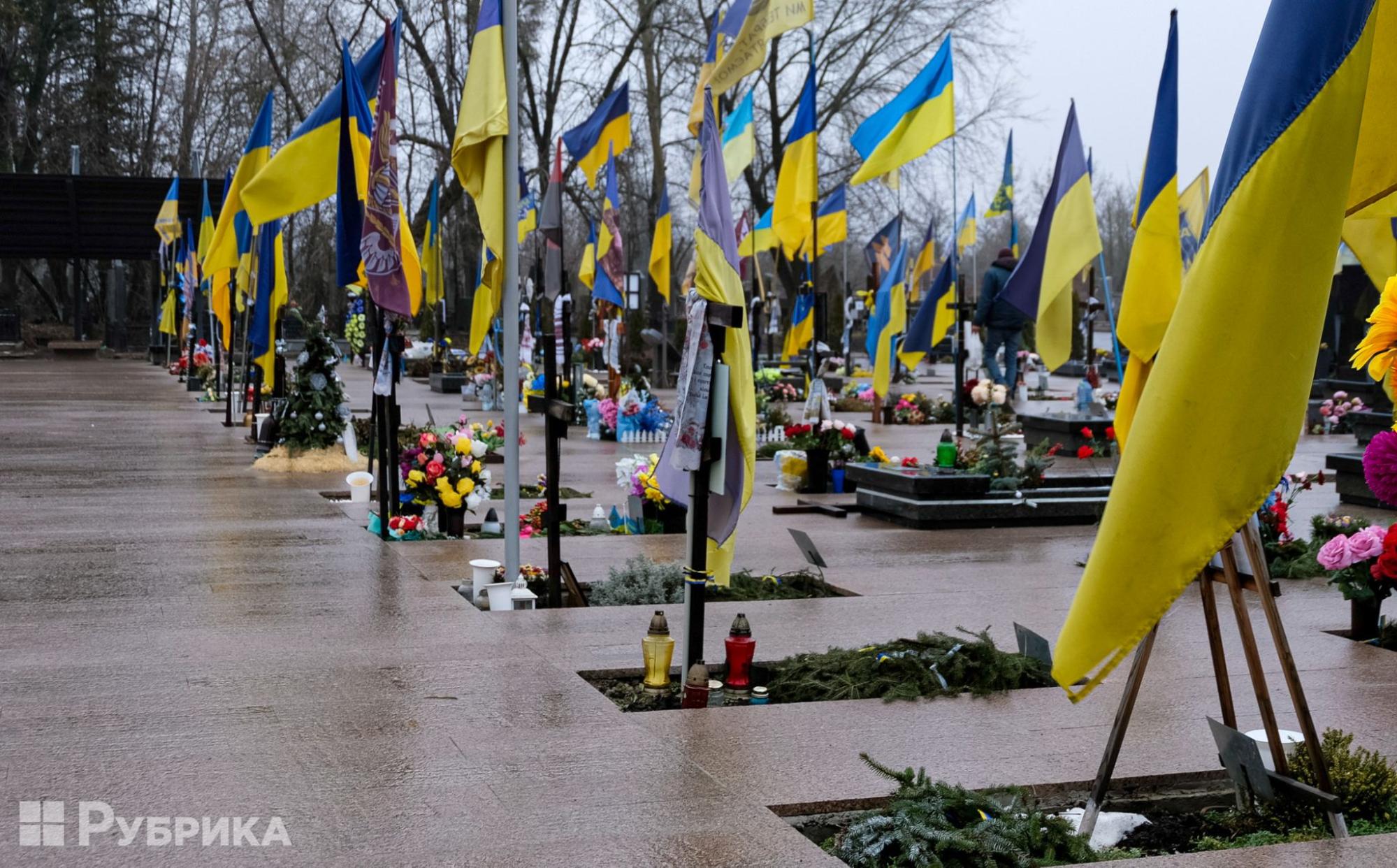
Berkovets cemetery today.
"We have a major issue with national remembrance. There is a gap between the expectations of families and the slow response from the state. Relatives want commemoration now—not just through monuments but through national recognition and respect. Grief doesn't wait. When people experience loss, they need a way to process it," explains historian Liahusha.
Society needs a space for silence, reflection, and honor—especially in Kyiv, where people from all over Ukraine come to pay their respects.
"Environmental impact assessment canceled for construction": why activists are protesting against the construction of the NWMC
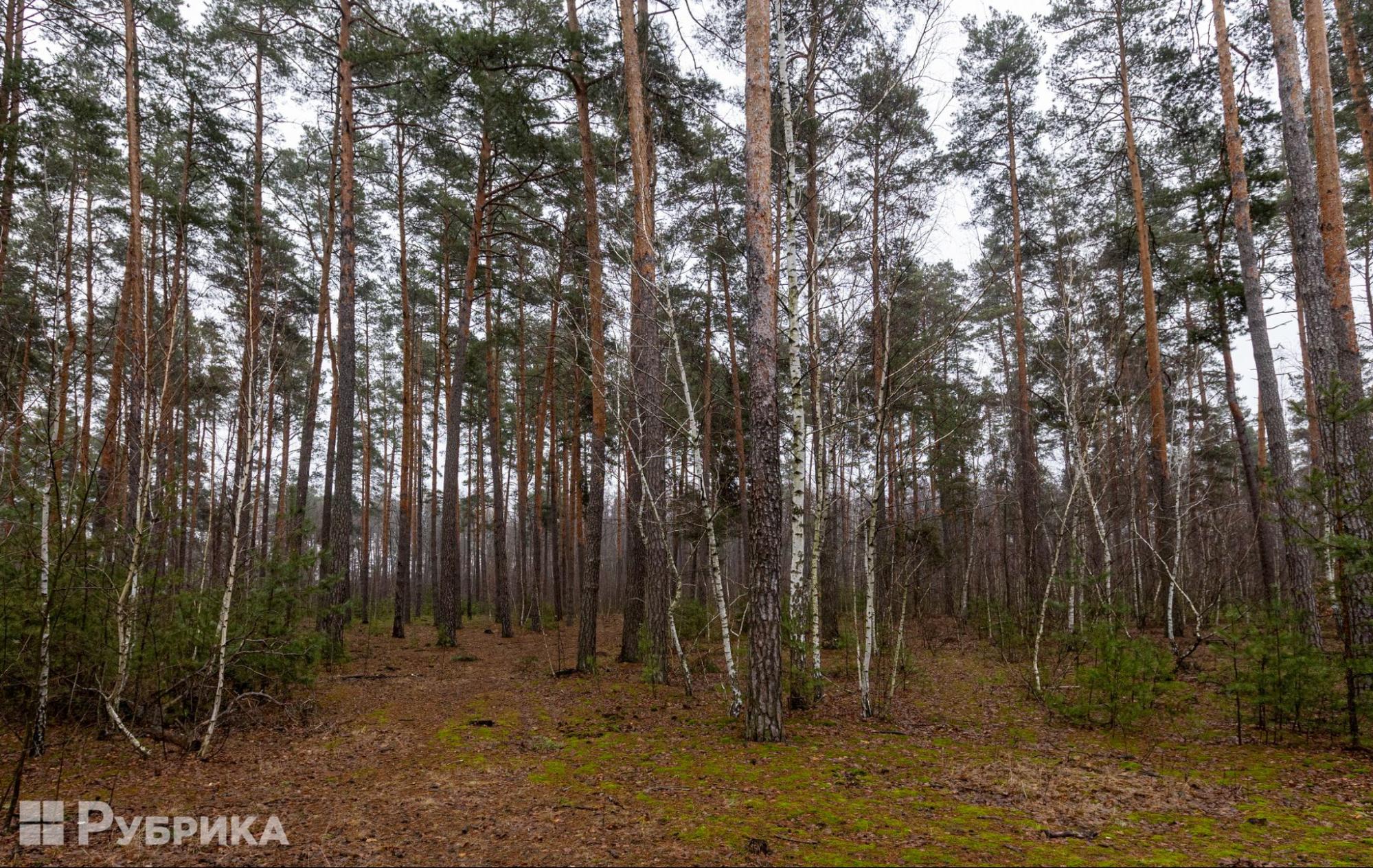
Markhalivskyi Forest, January 2025.
The village of Markhalivka, located just a half-hour drive from Kyiv, is nestled within dense forest. In April 2024, however, dozens of pieces of special equipment entered the forest, and the felling of trees for construction began. At the entrance to the site, a banner immediately catches the eye, placed by local activists who have been rallying against the construction for months.
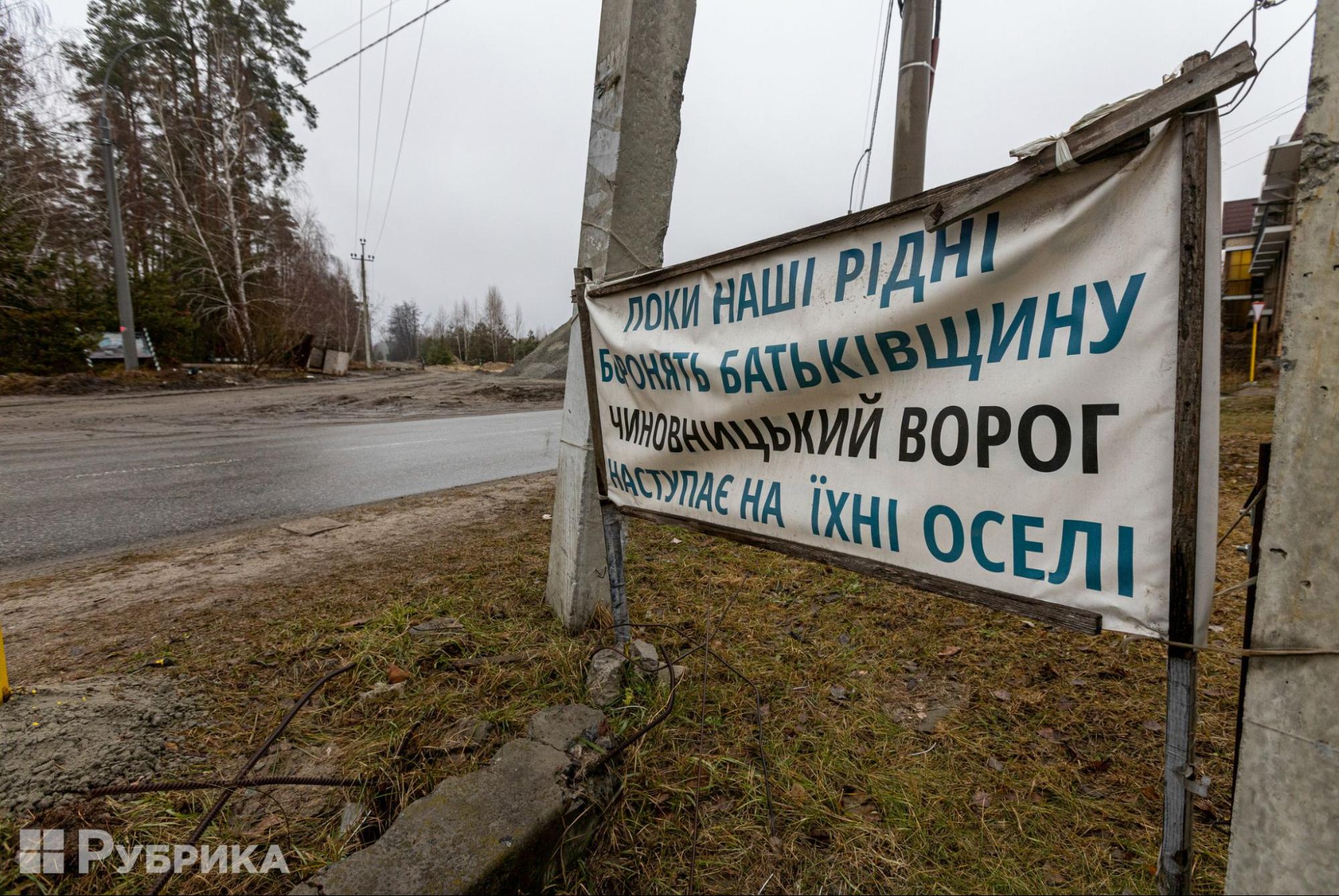
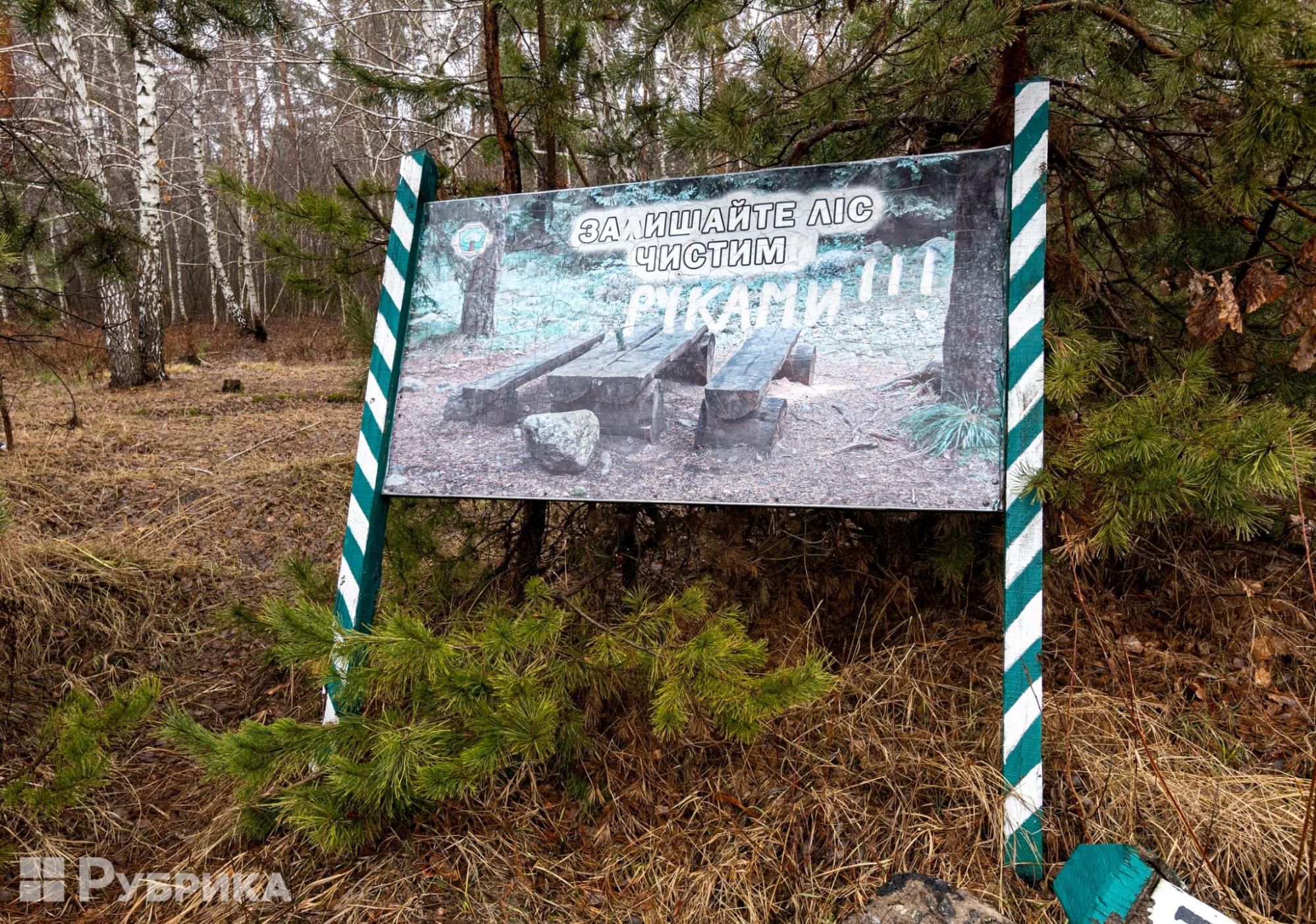
"None of the local residents knew what was happening at all. In the evening, the police were called, and they began to form an official investigative and operational group. Then, the gathered community was informed that construction was planned here. At that moment, they put up a facility passport, but it had no real details—just a drawing," recalls Viktoriia Chechenkova, a resident of Markhalivka. It was on April 1, 2024, that the village learned unexpectedly that construction work would begin on their land.
The decision to build on Markhalivskyi Forest was not immediate. Initially, authorities had planned to establish the National War Memorial Cemetery (NWMC) directly in Kyiv, specifically on Lysa Hora, a historic and culturally significant hill. However, after facing logistical and environmental concerns, the Cabinet of Ministers instructed the Kyiv City State Administration to reconsider and develop a detailed plan for a new site—Markhalivskyi Forest was selected instead.
The idea of building the cemetery at Lysa Hora was abandoned after strong criticism from activists, environmentalists, and deputies, as Lysa Hora is part of a nature reserve, making it an unsuitable site for construction.
The Kyiv City State Administration then proposed several other locations, including Spivoche Pole, Babyn Yar, Bykivnia, and Berkovtsi, all near existing cemeteries. However, none of these sites were approved for various reasons. In Bykivnia, concerns about a construction freeze arose due to the nearby memorial complex for victims of Stalin's repressions. If a mass grave were discovered, construction would have been halted indefinitely for research and exhumation.
Finally, in August 2023, the Ministry of Veterans Affairs decided that the National War Memorial Cemetery would be built in the Hatnianska territorial community, behind the Southern Cemetery, in the village of Markhalivka. According to the ministry's then head, the local community was informed and did not object. However, Anton Drobovych, head of the Ukrainian Institute of National Remembrance, later revealed that this location had actually been chosen back in 2015, during the early planning stages of the memorial.
On April 2, 2024, representatives from the National Committee for the Protection of Veterans and the Ministry of Veterans Affairs visited Markhalivka to address local residents and explain their plans for the National War Memorial Cemetery. The first major concern raised by the community was how the cemetery would be constructed in such a swampy area.
The project documentation outlines that the cemetery will cover nearly 267 hectares and be divided into several zones: entrance, administrative, economic, memorial and ceremonial, burial, memorial and educational, as well as sanitary and protective. The plan includes infrastructure such as bus stops, museums, a crematorium, a hotel, and more.
The cemetery is designed to accommodate 155,000 traditional burials and 5,000 in columbaria (for cremated remains).
When the community asked whether an environmental impact assessment had been conducted, representatives from the Ministry of Veterans Affairs responded that it had not, explaining that the law did not require it. This was due to the Ukrainian parliament's approval of bill 3505, which streamlined procedures by eliminating the environmental impact assessment, aiming to reduce bureaucracy and accelerate the cemetery's construction.
However, the concerns of local residents were later confirmed by an expert examination initiated by activists. A geological report from the National Ecological Center of Ukraine identified several issues with the site, the most critical being the high groundwater levels, which exceed two meters in some areas. This raises significant concerns about the feasibility of construction and the long-term stability of the cemetery.
The second concern raised by experts is the composition of the soil. According to Ruslan Havryliuk, head of the National Ecological Center of Ukraine, the sand between the groundwater and surface lacks the ability to filter water effectively. Without soil layers to purify and retain water, traditional burials could lead to contamination of the local water supply, including wells that nearby residents rely on.
The third issue is the fluctuation in water levels, which change with the seasons and rainfall. Scientists warn that these fluctuations could cause flooding in the forest area where the NWMC is planned.
The Ministry of Veterans Affairs claims that in 2023, prior to the commencement of construction, they conducted their own study, which found flooding in only 24 out of 60 wells in the area.
Based on the results of their study, officials from the Ministry of Veterans Affairs assured the public that burials would only take place in areas where the water level is within normal limits.
However, activists have provided copies of project documentation revealing that a similar study was conducted by the Ministry in February 2024. The conclusion of this study suggests that the water level could rise by 1.2 meters, potentially replenishing wetlands in the area.
"What worries us most is that the cemetery is designed for 100 years of operation, but the drainage system is only planned for 10 years. The question is what will happen after that? Will the system be able to handle heavy rainfall or changes in groundwater? If there are flooding problems, all the Ministry of Veterans Affairs could do is close everything down and rebuild," says Chechenkova.
The community has struggled to establish effective communication with representatives from the Ministry of Veterans Affairs. Activists claim the ministry repeatedly refused to provide them with necessary documents. On several occasions, before planned visits to the construction site, activists were detained by police officers and individuals claiming to be from the Ukrainian Security Service.
"Many people in our village are fighting, including women whose sons have died. They are participating in our defense. It's not that we are against the military; we just have concerns about the potential consequences this might have for the burials themselves. But, of course, it's being presented as though the community is entirely against the project," Chechenkova explains.
All problems stem from lack of transparency in decision-making
The public had barely recovered from the controversy over the site selection for the National War Memorial Cemetery when a new issue emerged—this time, regarding its architectural design.
On January 8, 2025, Ukrainian Pravda published an open appeal from the public to the President of Ukraine. Signed by servicemen, families of fallen soldiers, and public figures, the letter called on the authorities to hold a transparent architectural competition for the NWMC project.
The controversy arose when the state contracting authority announced a tender for a draft design, but only one company—LLC ENGINEERING-HOLDING—participated and was ultimately declared the winner. The competition lasted just 16 days, an unreasonably short time frame for a project of this scale.
For comparison, in Lviv, a similar competition for the design of a memorial cemetery lasted three months and received 27 submissions from across Ukraine.
However, even in that case, public debate followed. The winning concept was criticized for resembling a civilian cemetery rather than a military one. Currently, the project is being refined in consultation with advisory councils and families of the fallen.
The tender for the construction of the Kyiv cemetery also attracted only one participant—a consortium of contractors called Building.UA. One of the companies in this consortium is owned by Vadym Yermolaevyi, a businessman who was sanctioned for conducting business in Russian-occupied Crimea as recently as 2023.
Later, another controversy emerged. It was revealed that Serhii Derbin, the chief architect of the winning company in Kyiv, had traveled to Moscow in 2015 to attend a design conference. While this raised concerns, it was not the only issue. Experts have also criticized his architectural approach, citing a "lack of engagement with international best practices" and an overreliance on Soviet-era design principles.

Serhii Derbin. Photo from open sources
"We lack political will, responsibility, and transparency. For the authorities, the memorial is just another task to complete, rather than a true place of remembrance. And yet, the problem persists—the memorial still does not exist.
The public can and must highlight these issues, expose misconduct, raise their voices, and demand reasonable, adequate action from the government. That is exactly what people are trying to do now. But as a society, we cannot track every single step of what happens with the NWMC—who is responsible, where the funds are, and how they are being distributed.
What is clear, however, is that this will be the most important place of remembrance in Ukraine. And it is equally clear that we all must take an active role in shaping this crucial chapter of our history," says historian Liahusha.


